Vienna boasts an impressive clutch of glittering palaces, art-rammed galleries, Baroque streetscapes, grand monuments, and other landmarks due to its centuries-long position as the heart of the Habsburg Empire. These attributes along with its unmistakably cosmopolitan atmosphere and joie de vivre attitude make Vienna an essential place to visit.
For us, 3 days in Vienna is the perfect amount of time to explore what the city has to offer and leave enough for you to come back another time. Let us help you make the most of your trip, so you can experience some of the best things to do in Vienna in three days.
Please note that this article contains affiliate links. Learn more about it on our Disclosure page. We use ads to support our small business – we hope you don’t mind them too much.
Table of Contents
- 1 Getting To Vienna
- 2 Is 3 Days in Vienna Enough?
- 3 Is the Vienna City Card/Vienna Pass Worth It For 3 Days?
- 4 How to Get Around During Your 3 Days in Vienna
- 5 Your 3 Days in Vienna Itinerary
- 5.1 Day 1 in Vienna
- 5.2 Day 2 in Vienna
- 5.3 Day 3 in Vienna
- 6 More Than 3 Days In Vienna?
- 7 Popular Tours/Activities in Vienna
- 8 Popular Day Trips From Vienna
- 9 Where to Stay in Vienna
- 10 Further Reading For Your Vienna Visit
Getting To Vienna
Vienna’s only airport, Schwechat International, is located 19 km (12 miles) southeast of the city center. The quickest and most reliable way to get from Vienna Airport to the city center is by super-efficient CAT (City Airport Train), which runs to and from Wien Mitte Station.
The City Airport Train runs every 30 minutes during operating hours (05:35–23:35) Monday through Sunday, including public holidays.
Alternatively, you can also take one of the ÖBB Railjet trains from Vienna Airport to Vienna Central Station (Wien Hauptbahnhof). Trains run daily from the airport from 06.33–23:03, every 30 minutes. For detailed timetable and price information, please visit the ÖBB website.
The buses of Vienna Airport Lines (VAL) also run on three different routes from various points in the city to Vienna Airport. For detailed timetable and price information, please visit the VAL website.
Is 3 Days in Vienna Enough?
I think 3 to 5 days is the sweet spot for a trip to Vienna. When people ask me how many days they should spend in Vienna, I usually respond with a suggestion of 3 to 5 days.
While 3 to 5 days in Vienna won’t be enough to see everything or have an exhaustive exploration of the city, it gives you adequate time to get to know the most important attractions in the city.
Is the Vienna City Card/Vienna Pass Worth It For 3 Days?
When spending three days in Vienna, it might be a good idea to invest in a sightseeing pass/card given the city’s plethora of cultural attractions and sights. The Vienna Pass is the kind of tourist card you are probably used to where you pay a flat fee and gain free access to a large number of attractions.
The 3-day Vienna Pass costs a hefty 159 EUR but if you plan on seeing a lot of paid cultural attractions, it is a great choice. The only downside of the Vienna Pass is that it doesn’t cover public transport.
The Vienna City Card differs from the Vienna Pass as it doesn’t include free entrances to sites and museums, but rather offers discounts, usually in the range of 1-5€.
One of the main benefits of the Vienna City Card is that the discounts don’t only apply to sights and museums, but also to selected restaurants, shops, and leisure activities. It also allows unlimited free travel on the city’s metro, tram, and bus lines.
To find out which is the better alternative for you, read our in-depth comparison between the Vienna Pass vs Vienna City Card.
How to Get Around During Your 3 Days in Vienna
For this ‘3 days in Vienna’ itinerary, I primarily recommend exploring the city on foot. There is no better way to see the city than to walk around Vienna at your own pace.
Many of the major attractions are conveniently huddled together in close proximity and attractive streets are peppered with inviting plazas, gardens, and cafés offering plenty of places to stop.
Walking in Vienna is not without its hazards though. Traffic seldom stops at pedestrian crossings, so be alert when crossing the road. When walking, pay close attention not to walk along bike paths and tram lines, as this is prohibited and dangerous.
If you’re interested in a walking tour of central Vienna and seeing the city’s most popular highlights, check out this popular Vienna Walking Tour.
However, in order to save time or if the legwork gets too much, you should make use of the extremely efficient city transport system, known as the Wiener Linien. Vienna’s public transport network consists of trams (Strassenbahn), buses (Autobus), underground (U-Bahn), and trains (S-Bahn). Almost every part of Vienna is accessible by public transport.
Most of the main sights in Vienna’s historic center are located on the popular Ring Tram route. The U-Bahn is generally the quickest way to get around. It operates seven days a week from around 05:30 to 00:30. A 24-hour service runs on weekends and public holidays.
There are a number of ticket options ranging from a single ticket (2.40 EUR) to 24-hour (8 EUR), 48-hour (14.10 EUR), and 72-hour (17.10 EUR) tickets. Although tickets can be purchased at the ticket machines at U-Bahn and S-Bahn stations, it is best to buy a ticket in advance.
You can even purchase a mobile ticket using the Wiener Linien app. Children under six travel free on public transit, and children under 14 travel free on Sundays and public holidays providing they can show proof of age.
Tickets are valid for all public transportation—buses, trams, and the subway. You’ll need to punch your ticket before entering the boarding area at U-Bahn stops, but for buses and trams, you punch it on board.
If you’re caught without a ticket you’ll pay a hefty fine. You can plan your trip using public transport here.
If you’re visiting Vienna in the warmer months, exploring the city on a bicycle is a good option. The city has introduced a system of free bike rental called Citybike. Bicycles can be rented or returned from any of the 120 or so Citybike stations over the city.
To use a Citybike, you need to register first with a debit or credit card (at any Citybike Wien station or online), for a one-off fee of 1 EUR; when the bike is returned, the charge is calculated automatically and debited from your account.
In case you’re interested in seeing the highlights of Vienna on bike, check out this highly-rated Vienna Bicycle Tour.
If you’re not up for a long walk or cycle around Vienna, you could also get around on a segway, which can cover a larger area than a walk-around. In case you’re interested in seeing the must-see Vienna attractions on a segway, check out this excellent Vienna Segway Tour.
For those craving an audio guide and extra comfort, you can also get around the city with Vienna Hop-On Hop-Off Tour.
It is unlikely that you will have to use a taxi during your stay in Vienna but if the need arises it is easier to get a taxi at one of the taxi ranks rather than hailing it in the street. Alternatively, taxis can also be booked on the phone – there are three numbers: 313000, 40100, and 60160.
Your 3 Days in Vienna Itinerary
For your convenience, this post includes a free map that highlights the main points of interest in Vienna for three days. You can find the addresses of the attractions by clicking on the icons on the map.
Below I have compiled a list of the best things to see (or eat) in Vienna over the course of three days.
Day 1 in Vienna: Classical Vienna
Day One of this ‘3 days in Vienna’ itinerary will mostly focus on the classical sights in Central Vienna, i.e. all the sights that conjure up the most vivid and romantic images of the city. The winding streets and spacious squares of this area form the ancient core of Vienna.
Unsurprisingly, this is the most touristy part of Vienna. Don’t be daunted by the large number of sights I’ve mentioned. They’re mostly for observing from the outside.
Breakfast at Café Central

Kick off your 3 days in Vienna by heading to one of its famed coffeehouses. Vienna is the spiritual home of coffeehouses and since the late 19th century, coffeehouses have been the city’s most important social institution.
The best thing about the coffeehouses is that for the price of a small coffee, you can still sit for as long as you like without being asked to move on or buy another drink. That time can be used to relax, discuss business or politics, write, play cards, and above all, can go through an unlimited number of newspapers and magazines.
Although a lot of generic espresso bars and coffee shops are cropping up in Vienna, these establishments simply are no match to the role traditional Viennese coffeehouses have played in defining Viennese identity. Even today, there is still something unique about Viennese coffeehouses that makes them worth visiting.
The high ceilings, marble table-tops, velvety upholstery, bentwood coat stands, and notoriously brusque waiters all add to the unique flair. Each coffeehouse attracts a certain clientele and has its own atmosphere.

Café Central is Vienna’s most famous coffeehouse and undoubtedly its most palatial. Founded in 1876, This grand cafe offers a glimpse into 19th-century Viennese life, having been immaculately restored in the 1980s.
The interior of the café is very elegant with its chunky marble pillars, glowing chandeliers, and spectacularly vaulted ceilings. A popular meeting place for the city’s intellectuals, over the years Central’s clientele has included Tito, Freud, Hitler, and Lenin.
Central offers a vast selection of pastries and desserts, and Viennese and provincial dishes making it a fabulous place to have breakfast. Since coffee drinking is virtually an art form in Vienna, there is a legion of varieties to choose from.
Check the opening hours of Café Central on its website before your visit. Book a table in advance so as to avoid queues.
Fun Fact
Legend has it that coffee was first introduced to Vienna by a certain Georg Franz Kolschitzky, an Austrian spy who regularly penetrated the Turkish camp during the siege of 1683. When the siege was finally lifted, Kolschitzky was asked what he wanted in return for his services. He requested to be given the “camel fodder” – in actual fact sacks of coffee beans – left behind by the hastily departed Turks, and went on to open the first coffeehouse in Vienna the same year.
Vienna City Hall

Vienna City Hall (Rathaus) casts a distinctive and imposing shadow over Vienna’s cityscape. Built from 1872 to 1883 as the most expensive of all the grand buildings along the Ring Road (Ringstraße), this is in fact the New City Hall, replacing the Old City Hall in the inner city.
It is Neo-Gothic in style and serves as a powerful symbol of the city’s late 19th-century political clout. I think it kind of looks like a cross between a cathedral and a Gothic fantasy castle with its many spires and turrets.
The impressive building has seven arcaded courtyards and over 1500 rooms where the Vienna City Council and the mayor have their offices. The City Hall’s façade holds a lavish display of standard-bearers brandishing the coats of arms of the city of Vienna and the monarchy.
The building’s huge central tower is over 100 meters high and is topped by the 3-meter statue of a medieval knight in armor with a lance, known affectionately as the Rathausmann. Also worth noting is the lofty loggia with its intricate tracery and curved balconies.

In the month leading up to Christmas, when the city’s most famous takes place, the large square (Rathausplatz) plays host to the most famous Christmas Market (Christkindlmarkt) in Vienna.
At this time of the year, the square is crammed with stalls selling candy, hot mulled wine (Glühwein), decorations, and traditional wooden toys. After Christmas, this same area is turned into a huge outdoor ice-skating rink.
Although you can get a look at the ornate interior of City Hall by signing up for a guided tour, I wouldn’t recommend it for this itinerary due to time constraints.
Volksgarten
The elegant People’s Garden (Volksgarten) was created between 1820 and 1823 after the destruction of the city walls by Napoleon. Occupying a large triangular wedge, the People’s Garden is laid out in French formal style and has long been a favorite gathering place for the nobility.
I really like the People’s Garden for its geometric flower beds, beautiful rose garden, decorative fountains, long wide paths, and interesting monuments. At the northern end of the park is the wistful white-marble memorial to Empress Elisabeth (Sisi), Franz Josef’s Bavarian wife, who died of a dagger wound inflicted by an Italian anarchist in Geneva in 1898.
The focus of the park is the Doric Theseus Temple, a replica of the Temple of Hephaestus (Theseion) in the Ancient Agora of Athens. Commissioned by Napoleon to house Antonio Canova’s statue of Theseus and the Minotaur, its high, white marble columns and simple, low portico are rather attractive.
It is used for a range of changing exhibitions since the statue was transferred to the Art History Museum.
Hofburg
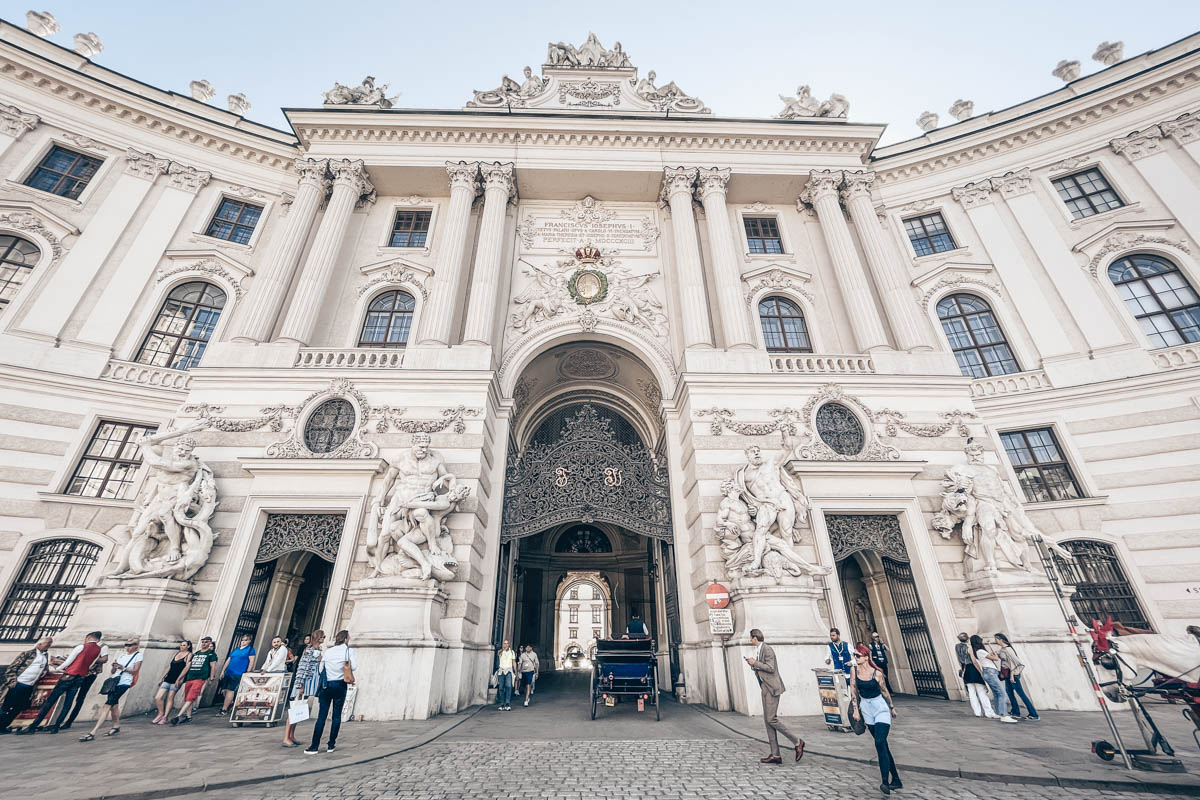
A sightseeing tour of Vienna wouldn’t be complete without taking a tour of the Hofburg (Court Palace). This sprawling palace was once the winter home of the Habsburgs. It is from here that the Habsburgs reigned supreme over Austria and large parts of Europe for more than six centuries, from 1279 until their downfall in 1918.
This vast complex of imperial edifices of varying architectural styles grew with the empire and today the palace is almost like a city within a city. It has 18 wings, 54 staircases, and some 2,600 rooms!
The Hofburg complex consists of the Imperial Apartments, two imperial treasuries, six museums, the National Library, and the famous Spanish Riding School, and the President of Austria’s offices.
There is so much to see and do in the Hofburg that there’s no way you can take it all in one day. Many people come to the Hofburg for the Spanish Riding School and the Vienna Boys’ Choir.
The real reasons to visit the Hofburg, though, are the Imperial Treasury (Schatzkammer), the richly decorated Baroque library (Prunksaal), and the exquisite Silver Collection (Silberkammer). To utilize your time well, I strongly suggest only focusing on these places.
Although the Hofburg has several entrances, try to enter through the majestic semicircular Michaeler Gate. It is the main entrance into the complex, and its imposing dome with golden decorations looms over Michaelerplatz.
This part of the city brings you back to the days when Vienna was the capital of a mighty empire and you will often see horse-drawn carriages cutting through the square.
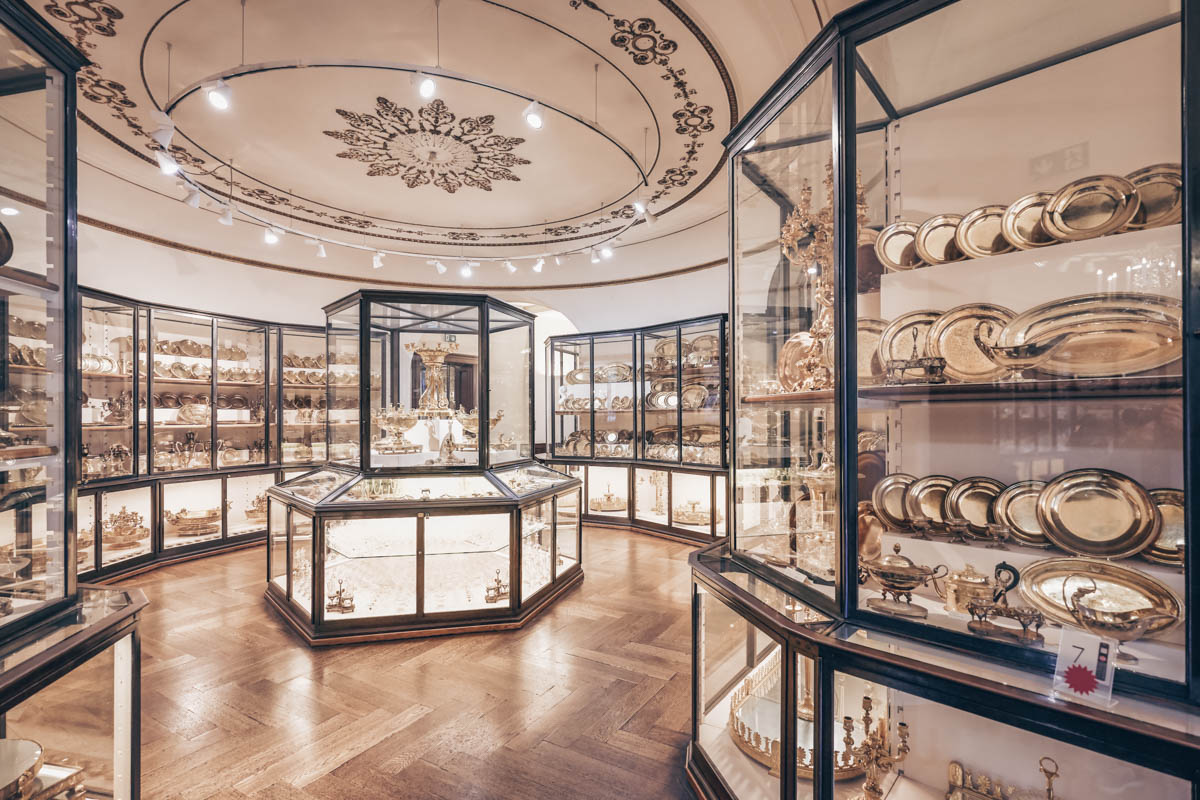
Once you pass through the spectacular portal gate of the Michaelertor—you can’t miss the four gigantic statues of Hercules and his labors—descend to the ground floor into the often-overlooked Silver Collection (Silberkammer).
The collection of elaborate kitchen utensils, bed linen, crockery, stone jugs, silver cutlery, and candelabras is top-notch. Also on display are several original imperial menus and napkins which give you a view of court life.
The highlight of the Silver Collection is the massive 19th-century Milan centerpiece. This gilded table centerpiece stretches more than ten meters and is decorated with allegorical figures and bronze-and-crystal urns.
Climb the marble Emperor’s Staircase (Kaiserstiege) to begin a tour of the Imperial Apartments. Quickly make your way through the 18 conventionally luxurious rooms where the emperors lived, along with their wives and children.
While the apartments are richly decorated, they can seem a little dull since virtually every room is decorated in the same style – creamy-white walls and ceilings with parquet flooring, gilded details, and red furnishing, which seems a bit prosaic.
Six rooms are devoted to the tragic empress Princess Elisabeth of Bavaria, lovingly known to Austrians as “Sisi”. The rooms display many of her treasured possessions, including her jewels, the gown she wore the night before her marriage, her wooden gymnastics equipment, and the opulent court salon railroad car she used.
Sisi enjoys an almost cult-like following in Austria ever since a 1950s trilogy of romantic films, starring Austro-French actress Romy Schneider as the empress.

Of all the things to see in the Hofburg, the Imperial Treasury is by far the most rewarding. It serves as a perfect foil to the dull Imperial Apartments. Some of the finest medieval craftsmanship and jewelry in Europe can be found here, including the imperial regalia and relics of the Holy Roman Empire.
The Habsburgs’ own crown jewels, the bounty of a once-great empire, including countless reliquaries and robes, goldwork, and silverware can also be found here.

There are a couple of other pieces that vie for your attention like the Holy Lance, reputedly the lance that pierced Jesus’s side, the Saber of Charlemagne, and the Imperial Crown, a sacred symbol of sovereignty once stolen on Hitler’s orders.
I really liked the Cradle of the King of Rome, which is adorned with gold and silver, while a goddess of victory crowns the child with a diadem of stars and a laurel wreath.

Finally, make your way to the National Library. It is one of the grandest Baroque libraries in the world, the focal point of which is the glorious Grand Hall (Prunksaal). The hall is stacked with shelves of invaluable leather-bound manuscripts in walnut wood bookcases from floor to ceiling.
Another highlight is the statue of Charles VI standing guard under the central dome, which itself has a magnificent fresco depicting the emperor’s apotheosis.
Practical Information For Visiting the Hofburg Palace Complex
The Silver Collection, Imperial Apartments, and Sisi Museum are open daily from 10:00–17:00 (15 EUR). The Imperial Treasury is open on all days except Tuesday from 09:00–17:30 (14 EUR).
The Austrian National Library is open Tuesday–Sunday from 10:00–18:00 (until 21:00 on Thursday). The entrance costs 10 EUR.
Hofburg Palace is also the location of the famous Spanish Horse Riding School (Spanische Hofreitschule). If you don’t feel like visiting the Imperial Apartments, you can catch the famous Lipizzaner horses in action in the stables instead.
Full demonstrations take place on Saturdays but on occasion, you can also attend training sessions in the morning on weekdays. Check the website for more information.
Heroes Square

Standing in front of Neue Burg, the somewhat asymmetrical Heroes Square (Heldenplatz) was left without a proper shape due to the fact that the Neue Burg was never completed.
The square owes its name to two Austrian war heroes: Prince Eugène of Savoy, the victor over the Turks in the 17th century, and Archduke Charles, Duke of Teschen, who defeated Napoleon in 1809 in Aspern, near Vienna.
Both of them are honored with a monumental equestrian statue. The one of Archduke Charles is particularly interesting as it depicts the horse cleverly balanced on its hind legs.
To the side of Heroes Square in the direction of the Ring Road is the Burgtor, a triumphal arch. It commemorates the Battle of Leipzig in 1813 where Austria and its allies defeated Napoleon’s outnumbered troops.
Traditional Austrian Lunch

For a well-deserved traditional Austrian lunch, head to Plachutta Wollzeile, a fantastic restaurant in the heart of Vienna. Oozing with style and finesse, this laid-back restaurant is a great place to sample classic Viennese and Austrian cuisine.
While you can try Austrian dishes such as the classic Wiener Schnitzel and Zwiebelrostbraten (roast beef with onions and sautéed potatoes), I highly recommend getting Tafelspitz.
The Wiener Schnitzel may be more well-known but no Austrian dish is more typical than the fabled tafelspitz favored by Emperor Franz Joseph. Boiled beef sounds dull, but Tafelspitz is far from bland.
It’s by far my favorite Austrian dish and I always have it when I’m in Vienna. It is normally served with fried grated potatoes and a mix of chopped apples and horseradish or sour cream mixed with chives.
Tafelspitz is a particular specialty at Plachutta and they offer 10 variations of the boiled beef dish. I recommend getting Schulterscherzel (shoulder of beef), Beinfleisch (juicy beef from the ribs), or the classic Tafelspitz (the rump of beef), but if you’re in doubt, ask the knowledgeable waitstaff. Make a reservation before you go to avoid waiting.
Mozart House

Vienna has been home to some of the biggest musical virtuosos in history. Arguably, the greatest of these was Wolfgang Amadeus Mozart who spent time in no less than 11 residences in Vienna.
This particular residence, in a relatively inconspicuous building in the inner city, is where the great composer and his family lived for three years from 1784 to 1787.
The first-floor apartment was Mozart’s most luxurious residence in Vienna and the one which he liked the most. It is also where he composed a significant number of works like the melodic Haydn Quartets and The Marriage of Figaro.
The apartment is now home to a museum with displays about Mozart’s life and the masterworks that he composed here.
St. Stephen’s Cathedral

St. Stephen’s Cathedral (Stephansdom) is undoubtedly one of Vienna’s top attractions. It has endured a lot of attacks in its long history including two Turkish sieges, Napoleonic bombardment, and World War II bombings. The cathedral’s survival through all those conflicts is seen as a miracle and has made it the city’s most beloved landmark.
The foundations of the original Romanesque church date back to 1147, but the earliest surviving features today are the 13th-century Giant’s Door (Riesentor) and the Heathen Towers (Heidentürme) on the west side. St. Stephen’s Cathedral lacks a definite symmetry and is an intriguing architectural ensemble ranging from 13th-century Romanesque to 15th-century Gothic.

St. Stephen’s Cathedral steeply pitched yellow, blue, and green rooftop has been fancifully decorated with almost a quarter of a million glazed tiles that are said to be modeled on a Saracen carpet.
They form enormous mosaics depicting a double-headed eagle (symbol of the Holy Roman Empire) and the coats of arms of Vienna and Austria.
The cathedral is inextricably intertwined with Viennese and Austrian history. Many notable events have taken place here including Mozart’s marriage and funeral. Napoleon even posted his farewell edict on the door in 1805.
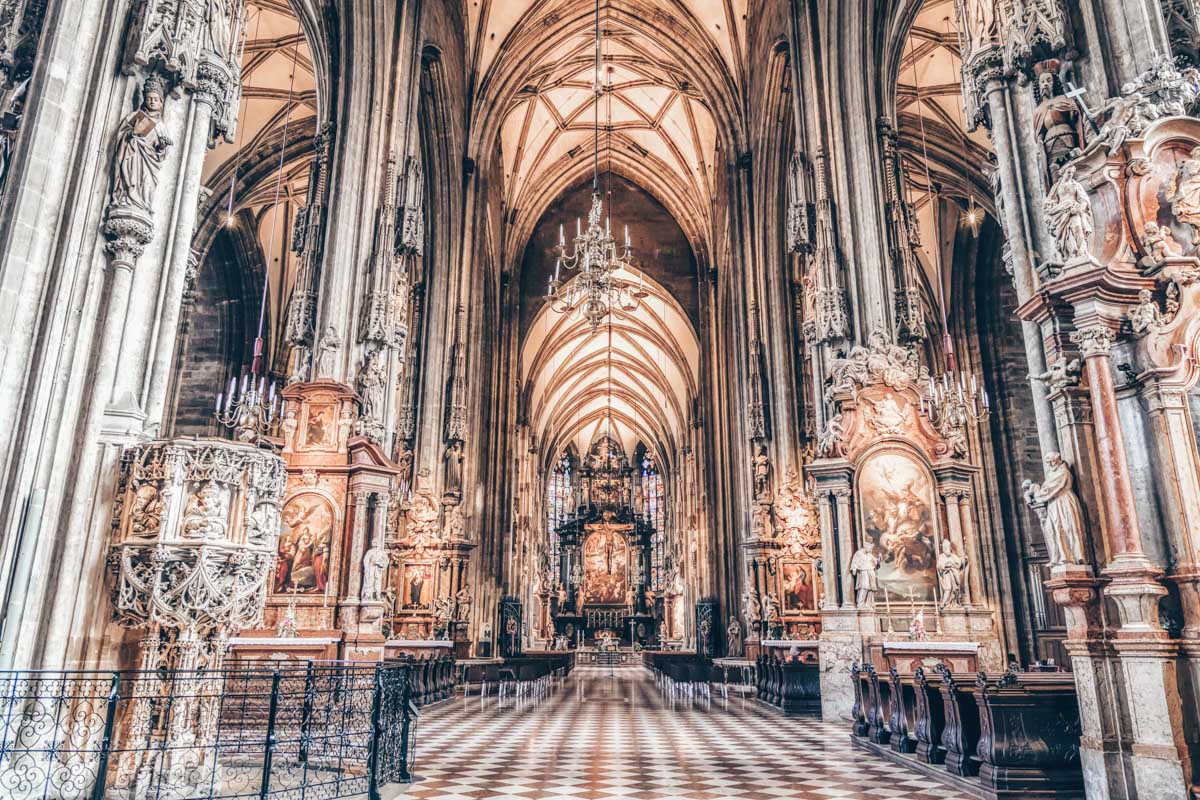
The nave of St. Stephen’s Cathedral is enormous and stands out due to its Gothic vaulted ceiling. While the cathedral is mostly Gothic in style, the exquisite marble and stone high altar are clearly Baroque.
The altar shows statues of four saints and the central painting shows the martyrdom of St. Stephen.

One of the other highlights of St. Stephen’s Cathedral is the early 16th-century carved stone pulpit, masterfully crafted by stonemason Anton Pilgram.
It contains portraits of the four fathers (saints Augustine, Gregory, Jerome, and Ambrose) of the Christian Church. Each is given a different personality.
The staircase is beautifully adorned with figures of lizards, salamanders, and toads pursuing one another up the banister, symbolizing the fight of good against evil. I love how Pilgram himself makes a cameo, as he devilishly looks out of a window at the foot of the stairs.

The cathedral piece de resistance, however, is undoubtedly the elaborate Wiener Neustadt Altar. This richly gilded masterpiece from the mid-15th century is composed of two triptychs.
If the altar’s wings are closed (on weekdays), only four rows of saints will be depicted; when open (on Sundays), they reveal gilded wooden figures depicting events in the life of the Virgin Mary.
Other highlights of the interior include the centuries-old sculpted Renaissance tomb of Emperor Frederick III. Consisting of pinkish Salzburg marble from the 17th century, the carved tomb depicts hideous hobgoblins trying to wake the emperor from his eternal sleep.
The Chapel of St. Catherine featuring the four apostles is also worth noting. You can also check out the catacombs which are lined with cages filled with bronze caskets containing the remains of the later Habsburgs.
If you’re up for the challenge, you can even scale the cathedral’s south tower which soars to a height of 137 meters. Ironically nicknamed “Steffl” (Little Stephen) by the Viennese, you can scale the 343 steps leading to a viewing platform offering far-reaching views of Vienna.
Finally, the acoustics of St. Stephen’s Cathedral in Vienna are outstanding. The cathedral’s grand Gothic structure and expansive, echoing nave expertly propagate sound, enabling the finer details of the music to resonate magnificently across the area. Concerts in this setting provide a rich auditory experience, augmented by the cathedral’s historical and visually stunning atmosphere.
Practical Information For Visiting St. Stephen’s Cathedral
St. Stephen’s Cathedral is open from 09:00-11:30 & 13:00-16:30 (Monday-Saturday); and 13:00-16:30 (Sunday and public holidays). The entrance to the cathedral is free. However, there are parts within the church to which there is only paid access.
For 6 EUR, you can take a guided tour of the catacombs beneath St. Stephen’s Cathedral. Guided tours usually take place half-hourly during visiting hours.
It is also possible to visit St. Stephen’s Cathedral’s two towers – the North Tower and the South Tower, both of which offer different viewing perspectives.
For a close-up view of St. Stephen’s Cathedral’s iconic multi-colored mosaic tiling, visit the North Tower. It is open daily from 09:00-20:30 (last entrance at 20:00). Tickets cost 6 EUR.
Alternatively, for unobstructed panoramic views of Vienna’s cityscape, visit St. Stephen’s Cathedral’s South Tower. It is open daily from 09:00-17:30 (last entrance at 17:15). Tickets cost 5 EUR.
Fun Fact
The Stephansdom’s “Pummerin” (Boomer) bell, located in the North Tower’s cupola, is Austria’s largest and heaviest. It weighs nearly 20 tons, and was cast from 100 cannon balls seized during the Turks’ failed siege of Vienna in 1683. It is used just once annually—to ring in the New Year. Beethoven discovered the totality of his deafness when he realized he could no longer hear the sound.
Graben

The pedestrianized shopping street of Graben is one of the most exclusive shopping streets in Vienna. It still retains an air of exclusivity and many of its upscale shops still bear the “k. k.” and “k. u. k.” – kaiserlich und königlich (Imperial and Royal) tag.
The name Graben literally means “moat” or “ditch which comes from the fact that it was once a moat that lay outside the Roman camp. Graben is lined with an eclectic brand of architecture ranging from Baroque, Art Nouveau, or Belle Epoque eras.
St. Peter’s Church

St. Peter’s Church (Peterskirche) is my favorite Baroque church in Vienna and that says something in a city where there are several fine Baroque churches. The church is positioned in a small square and is almost obscured by the buildings surrounding it.
The most vivid feature of the twin-towered church is its great turquoise-colored oval dome. St. Peter’s Church dates from the early 18th century and was modeled on St. Peter’s in Rome.
The church’s sumptuously decorated interior is full of pomp and grandeur and features an abundance of marble pilasters, gilded woodcarvings, rich stucco, and exuberant frescoes. The High Baroque main altar, the fabulous Trompe-l’oeil cupola painting, and the gilded pulpit are worth noting.
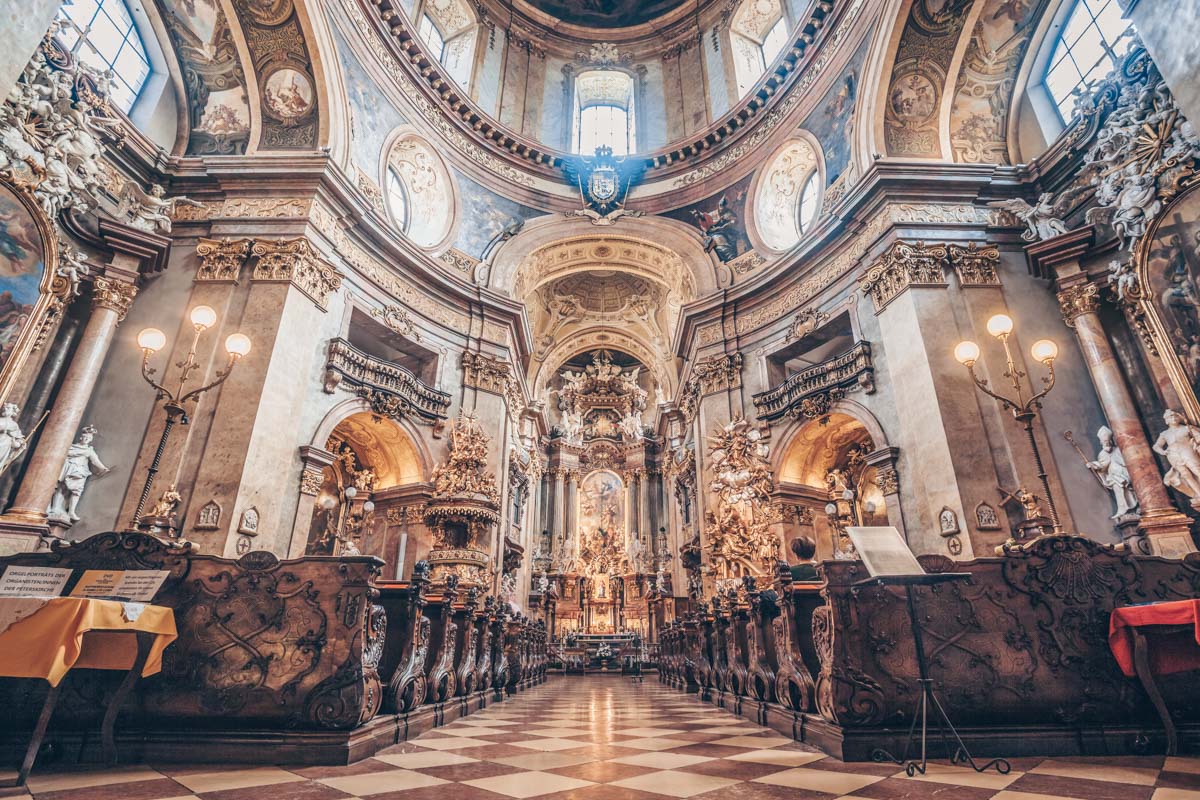
I really love the gold and silver monument depicting St. John of Nepomuk being thrown into the Vltava River off Prague’s Charles Bridge after refusing to divulge the secrets of confession, with King Wenceslas IV overlooking the proceedings. The spectacular fresco on the domed ceiling entitled The Assumption of the Virgin Mary is another standout.
Similar to St. Stephen’s Cathedral, St. Peter’s Church is an ideal venue for classical ensemble performances, thanks to its rich acoustics and stunning baroque architecture. Frequently hosting concerts, this church allows audiences to enjoy a variety of classical music styles in an intimate and historically resonant setting.
St. Peter’s Church is open from 07:00-20:00 (Monday-Friday) and 09:00-21:00 (Weekends and public holidays). Free entrance.
Dinner
Cap off your first day of sightseeing in Vienna by treating yourself to a well-earned dinner. QERO Peruvian Cuisine & Bar is a chic restaurant specializing in Peruvian classics like Aji de Gallina (Creamy Chicken), ceviche, and Lomo Saltado (Stir-Fried Beef).
Day 2 in Vienna: Imperial Vienna
Day Two of this ‘3 days in Vienna’ itinerary will mostly focus on the two imperial palaces in Vienna – the Belvedere and the Schönbrunn, and the Prater, the former royal hunting ground.
Breakfast at Café Demel
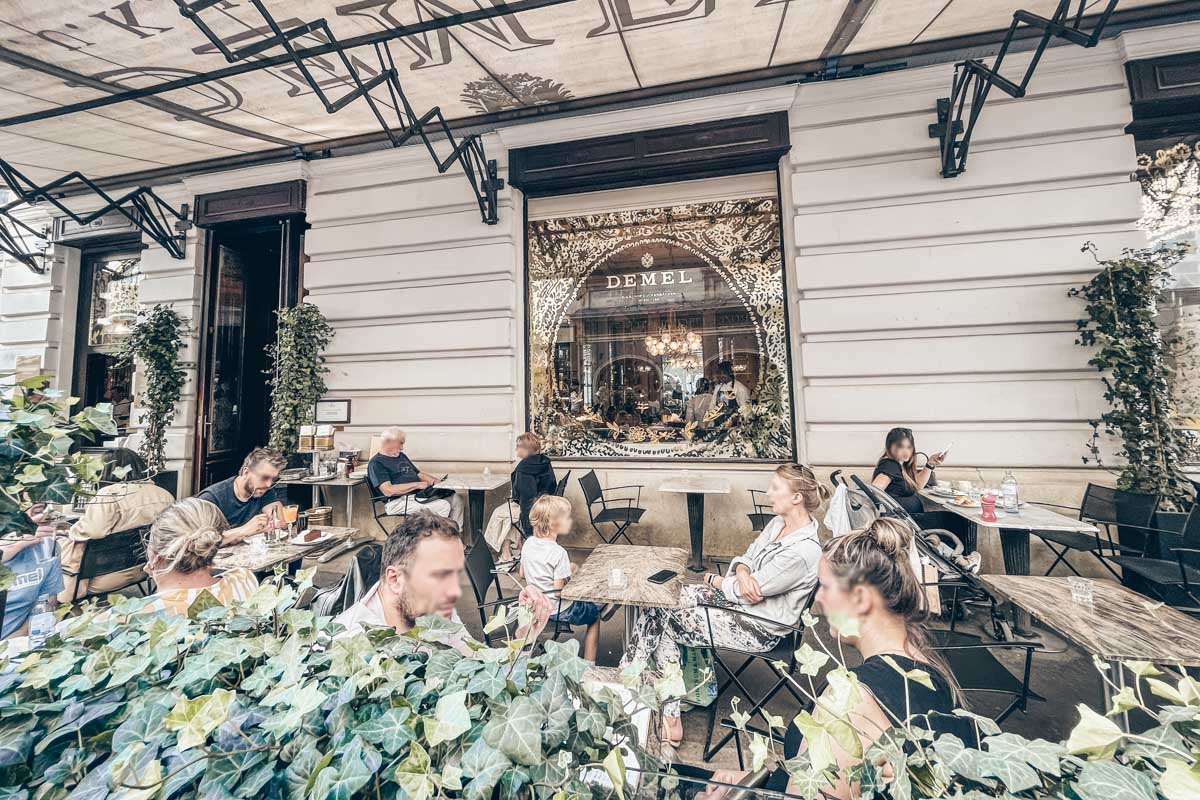
If you have a sweet tooth, you shouldn’t miss out on Demel (K. u. K. Hofzuckerbäckerei Demel) during your visit to Vienna. It is arguably the most famous café and pastry shop in Vienna and has been around since 1786.
Demel moved to its current location in 1888 and now boasts the city’s finest array of delectable pastries and desserts. Demel’s edible art pieces in the shop windows are a work of art as are the café’s Rococo salons, gilded mirrors, and coffered ceilings.
Don’t miss out on house specialties like the “Demeltorte” and the chocolate nougat “Annatorte”. The “Apple Strudel” and the “Esterhazy Torte” are also amazing!

Demel is also known for its longstanding feud with the Hotel Sacher Wien, over who has the right to sell the famous “Original Sachertorte”, a chocolate sponge cake covered with chocolate icing, filled with a layer (or two) of apricot jam.
In the 1960s, a court ruled in favor of Hotel Sacher, but Demel still claims that Eduard Sacher (cake creator Franz Sacher’s son) gave them the exclusive rights to use his name and recipe.
To be honest, the Sachertorte at both Demel and Hotel Sacher is pretty similar although you’ll hear strong arguments about why one is better than the other.
I don’t really care much for Sachertorte anyway since it’s a tad overhyped and other Austrian cakes are way better. You should try one though anyway.
Demel is open daily from 10:00–19:00. Book a table in advance so as to avoid queues.
Schönbrunn Palace
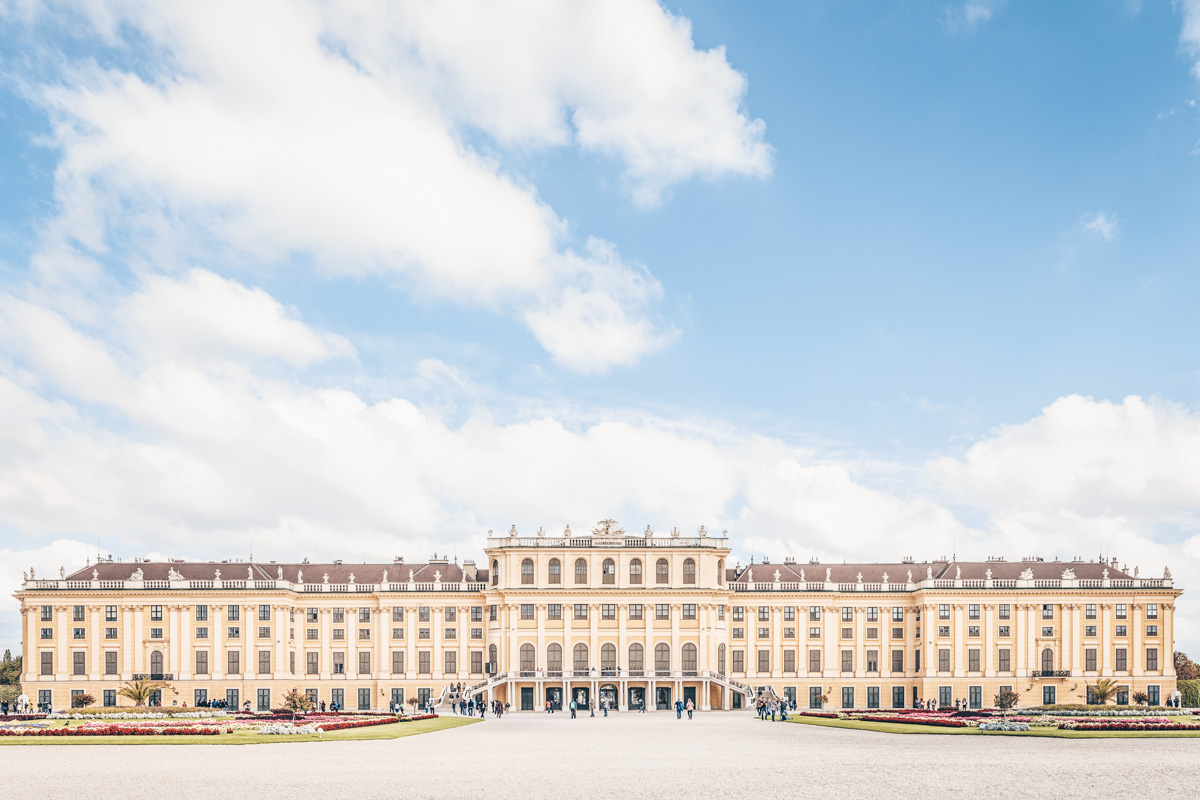
Visiting the grand Schönbrunn Palace is one of the best things to do in Vienna. What Versailles is to France, Schönbrunn is to Austria. Schönbrunn served as the former summer residence of the Habsburgs and symbolizes what an imperial residence ought to be: symmetrical, palatial, and imposing.
Schönbrunn was initially built between 1696 and 1712 at the behest of Emperor Leopold I for his son, Joseph I. Leopold envisioned a palace whose grandeur would surpass that of Versailles. Unfortunately, these grand plans were never carried out due to a lack of support from the nation’s treasury which was drained by the costly wars.
Construction on Schönbrunn started and was altered in the mid-18th century when Maria Theresa became empress and the way the palace looks today is a lot like she conceived it. The central palace measures 175 meters in width and has a symmetrical Baroque façade.
It is painted in a light yellow/ocher manner (Schönbrunn yellow), a combination that can be seen throughout many residences in Austria.
The interior of Schönbrunn is opulent with a superb array of Rococo State Rooms (Prunkräume). The extravagant decor of these rooms gives an evocative insight into the lives of the royals. Of the palace’s 1441 rooms, only 40 are accessible to the public.
Many of the rooms are adorned with priceless furniture and white paneling, which is often adorned with a gilded ornamental framework. Of course, the rooms vary from extremely sumptuous to rather plain.
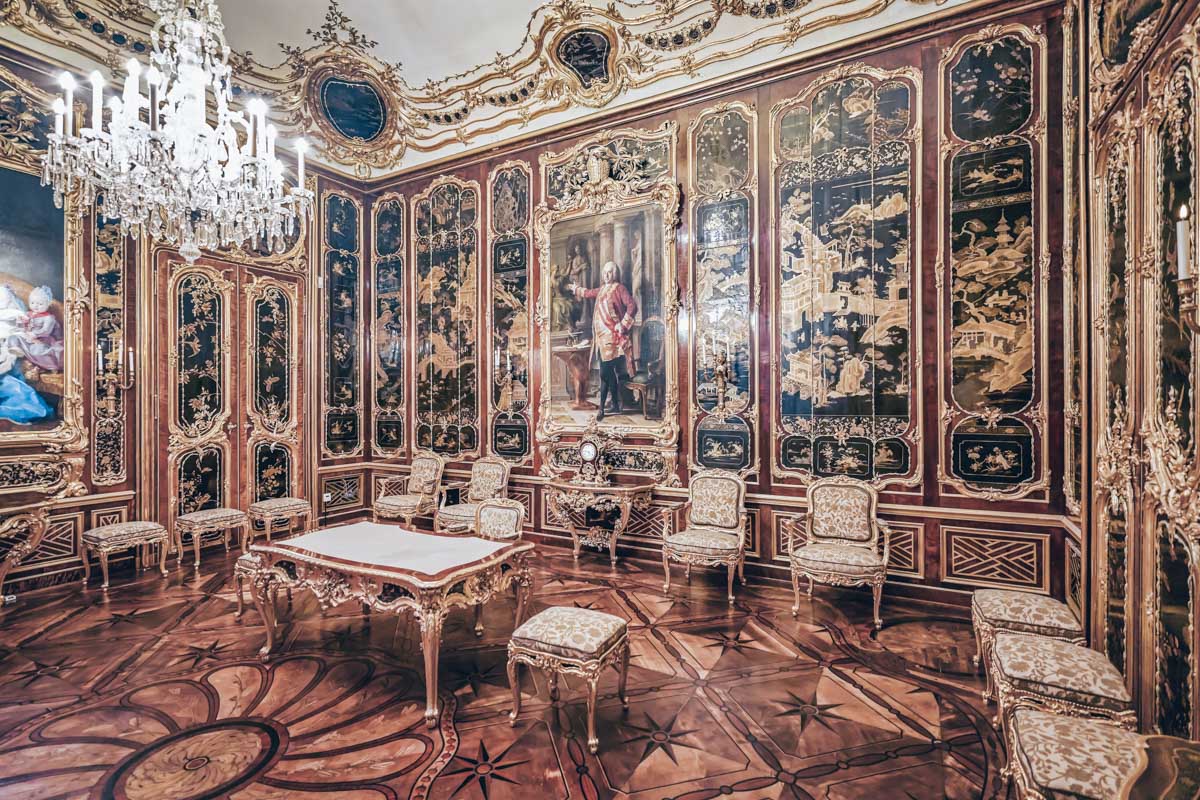
I really love the Vieux-Laque Room, whose glistening interior blends Rococo elements and Oriental art. Black lacquer panels from Beijing are set into walnut paneling and embellished with gilt frames.
The panels show birds, landscapes, and flowers. Maria Theresa lived in this room during her widowhood and had several portraits of her husband Franz Stephan hung here as a memorial.
The Millions’ Room is particularly fascinating and is so named because it’s estimated that Maria Theresa paid more than a million Gulden (former Austrian gold coins) to have it decorated with fabulous Caribbean rosewood paneling.
The room’s Indo- Persian miniatures portray scenes from the lives of the Mughal rulers of India in the 16th and 17th centuries.

Of course, the Great Gallery is also splendid. The 40-meter-long hall is a highpoint of Rococo design with its tall windows, splendid crystal mirrors, chandeliers, and white-and-gold stucco embellishments. It has some fabulous ceiling frescoes as well.
The hall was used for banquets during the 1815 Congress of Vienna, and it was here, in 1961, that J.F. Kennedy and Nikita Krushchev held their historic détente meeting.
The other prominent room is the Mirror Room, which features stunning white-and-gold Rococo decoration and crystal mirrors. It is famous for being the room where, in 1762, the precocious six-year-old Mozart performed a private duet with his older sister Nannerl, for Empress Maria Theresa.

After touring the state rooms, you should take a stroll in the Schönbrunn Palace Park (Schönbrunn Schlosspark). The glorious gardens are worthy enough on their own to make the trip to Schönbrunn.
The park is laid out in Baroque style across a sloping landscape making it ideal for scenic vistas. The central axis of the parterre is lined with beautifully regimented flower beds flanked by rows of stone statues.
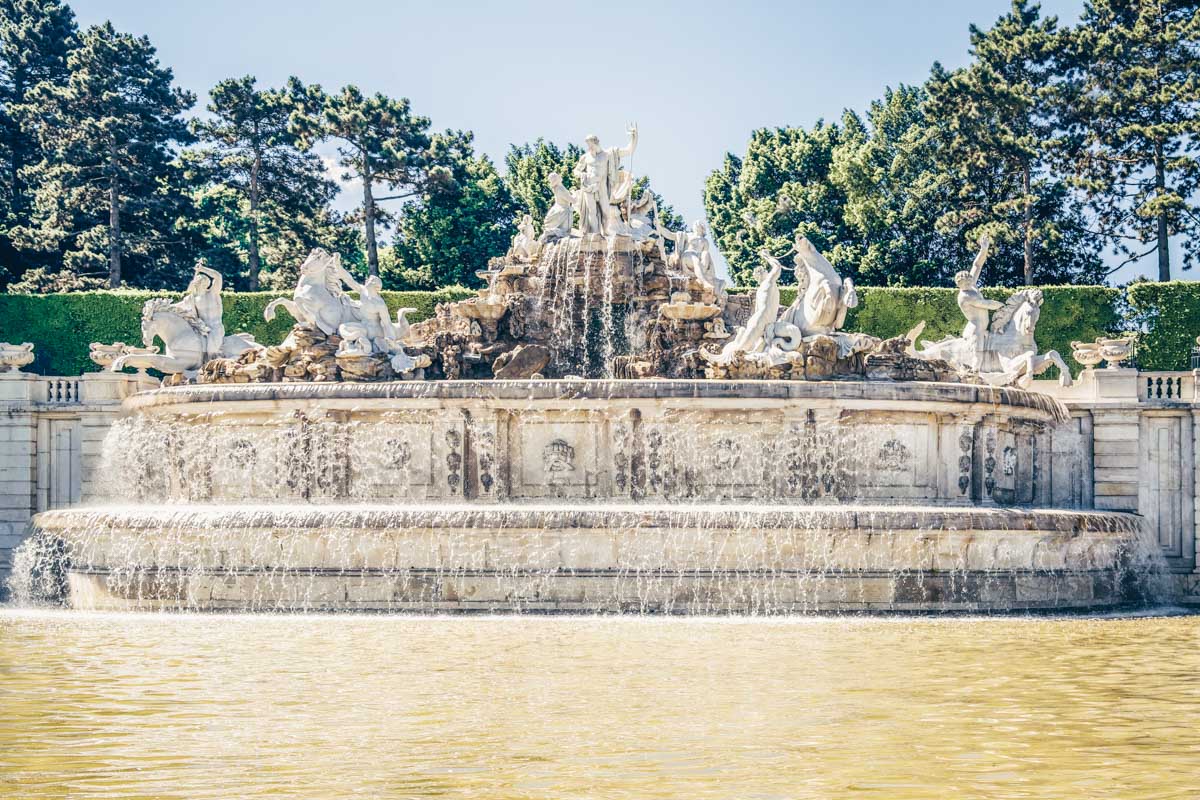
As you make your way up the slope, take a moment to admire the Neptune Fountain (Neptunbrunnen). This lovely Baroque fountain shows a mythical scene in which the sea god Neptune is presiding over his entourage of nymphs, goddesses, horsemen, sea horses, and other characters.
Kneeling below Neptune, Thetis pleads with him for calm seas to ensure her son Achilles a safe voyage to Troy.
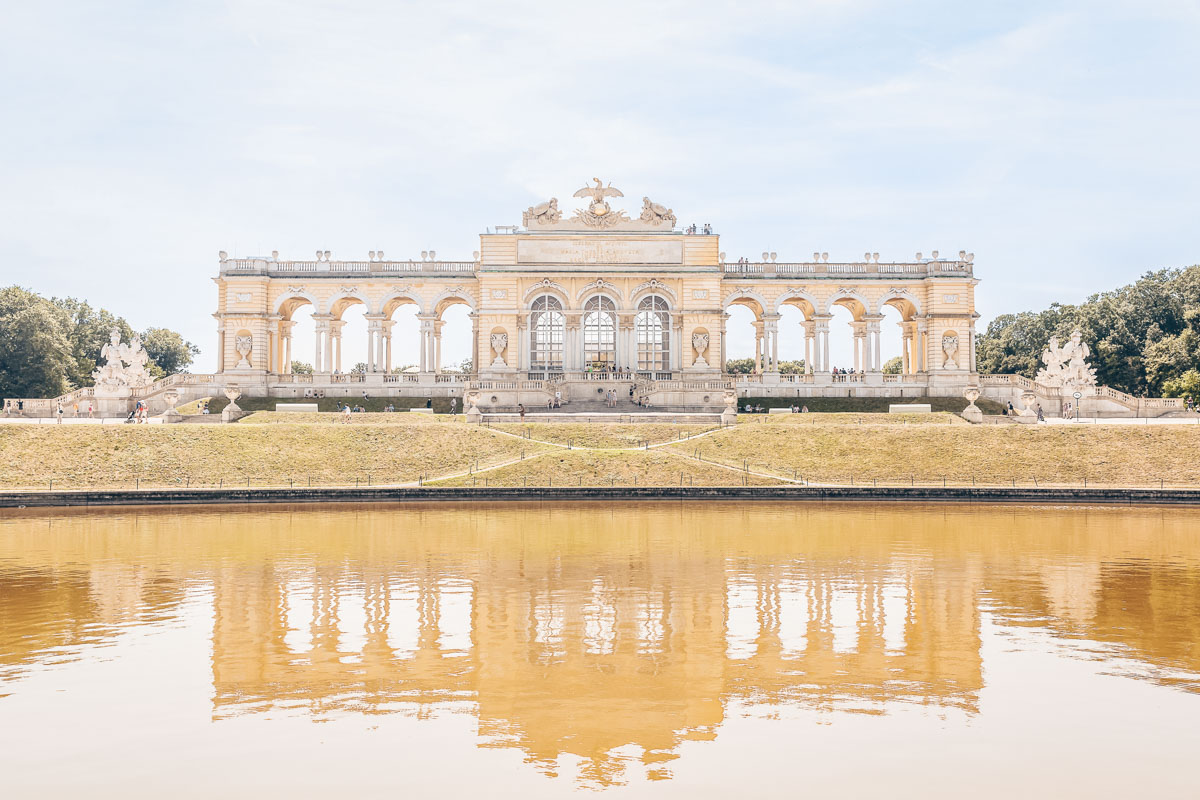
The picturesque Gloriette sits at the apex of Schönbrunn’s hill. This triumphal arcaded structure was built in Neoclassical style to celebrate the 1757 victory of the Habsburgs over the Prussians at the Battle of Kolín.
The gloriette was formerly used as a dining hall and is now home to a café. Today, you are treated to a magnificent panoramic view not only of Schönbrunn Palace and the Gardens but also over Vienna.

One other aspect of Schönbrunn Park I love is the maze and the labyrinth. The maze is a conventional head-height maze consisting of winding hedges that is quite challenging to navigate.
If you’re young at heart or have kids in tow, the Labyrinth’s fun stepping-stones, glockenspiel grid, zany mirrors, and mathematical teaser will prove great fun.

Another notable feature is an architectural folly of Roman Ruins, built in 1778. Such ruins were in vogue at the time and provided a romantic backdrop for open-air concerts and theater productions.
The park is also renowned for its magnificent tropical Palm House, which is home to a glorious canopy of palm trees and lots of rhododendrons, lilies, hydrangeas, and cacti.

The park is also home to a botanical garden, an orangery, a privy garden, a zoo, and much more. Schönbrunn Palace and the Schönbrunn Palace Park are open daily throughout the year.
The entrance to the palace park is free with the exception of special attractions like the maze, privy garden, and the orangery.
Practical Information For Visiting Schönbrunn Palace
The opening hours of both the Schönbrunn Palace and palace park vary according to the time of year. Check opening hours and prices here.
To see the interior of Schönbrunn Palace, take the Grand Tour, which includes all forty rooms and the palace’s most magnificent Rococo delights.
As Schönbrunn is one of the most popular Vienna attractions, I strongly recommend booking your ticket online in advance to avoid long queues and waiting times!
Lunch
There aren’t a lot of dining options nearby Schönbrunn Palace but Restaurant Sokače is a great option when visiting the palace. This Serbian restaurant offers an array of tasty Balkan grills and sausages.
Belvedere Palace

The Belvedere Palace is one sight that no visitor to Vienna should miss. The grand palace complex actually consists of two imposing Baroque palaces that are separated by a 17th-century French-style garden parterre replete with fountains, cascades, and statuary.
More so than the Hofburg and the far more famous Schönbrunn Palace, I firmly believe the Belvedere Palace is the most impressive palace in Vienna, at least from the outside.
The Belvedere was built outside the city fortifications between 1714 and 1722, the complex originally served as the summer palace of Prince Eugene of Savoy, Austria’s greatest military leader who oversaw the Habsburgs’ defeat of the Turkish army in 1683.
The prince was an avid patron of the Arts and amassed a large collection of paintings and sculptures from across Europe. Today, both palaces are state museums, and within their walls lie opulent rooms and famous works by Gustav Klimt and other European masters.
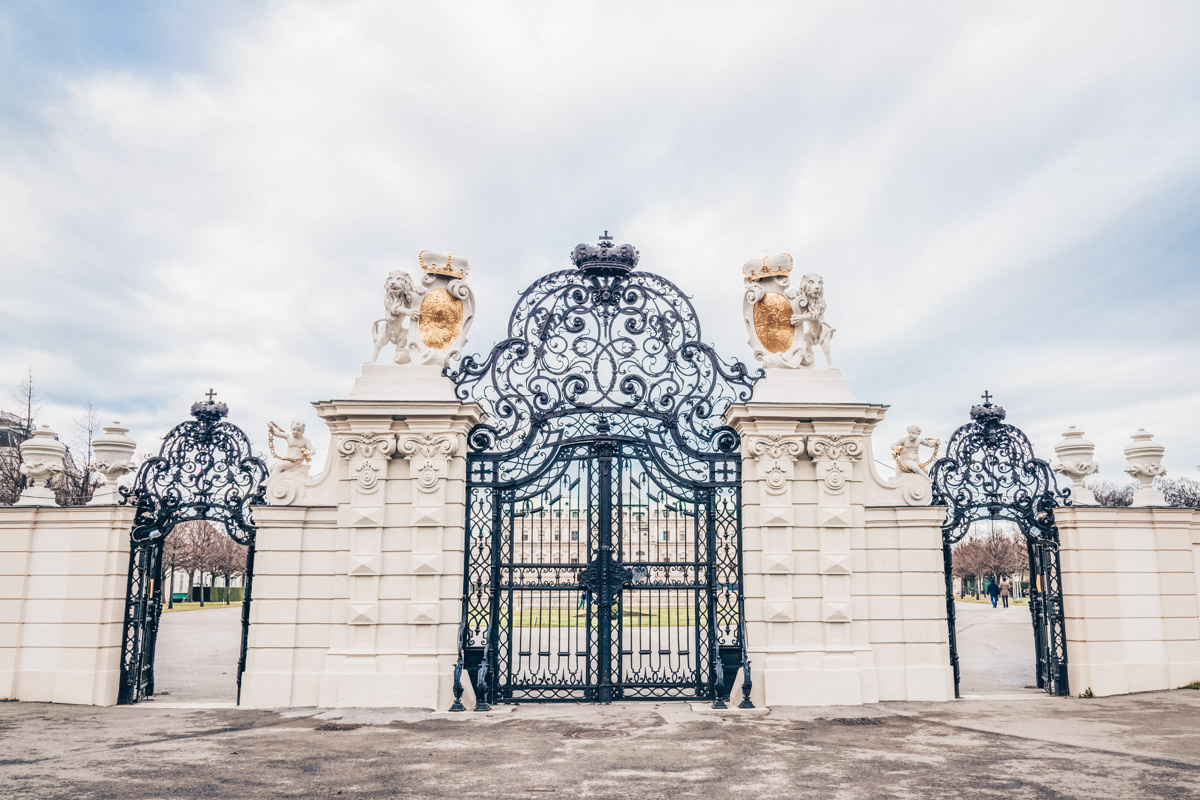
Though the Lower Belvedere is impressive in its own right, it is the much larger Upper Belvedere, used for state receptions, banquets, and balls, that steals the show.
The main entrance gate of the Upper Belvedere is a lovely Baroque iron gate that features a pair of standing lions, each showing a gilded crest of Prince Eugene of Savoy.
It’s hard not to be impressed by the Upper Belvedere’s elaborate façade. Its domed copper roofs resemble the shape of Turkish tents as a symbolic reflection of Prince Eugen’s victory. The numerous sculptures that adorn its façade are an allusion to the victory over the Turkish army.
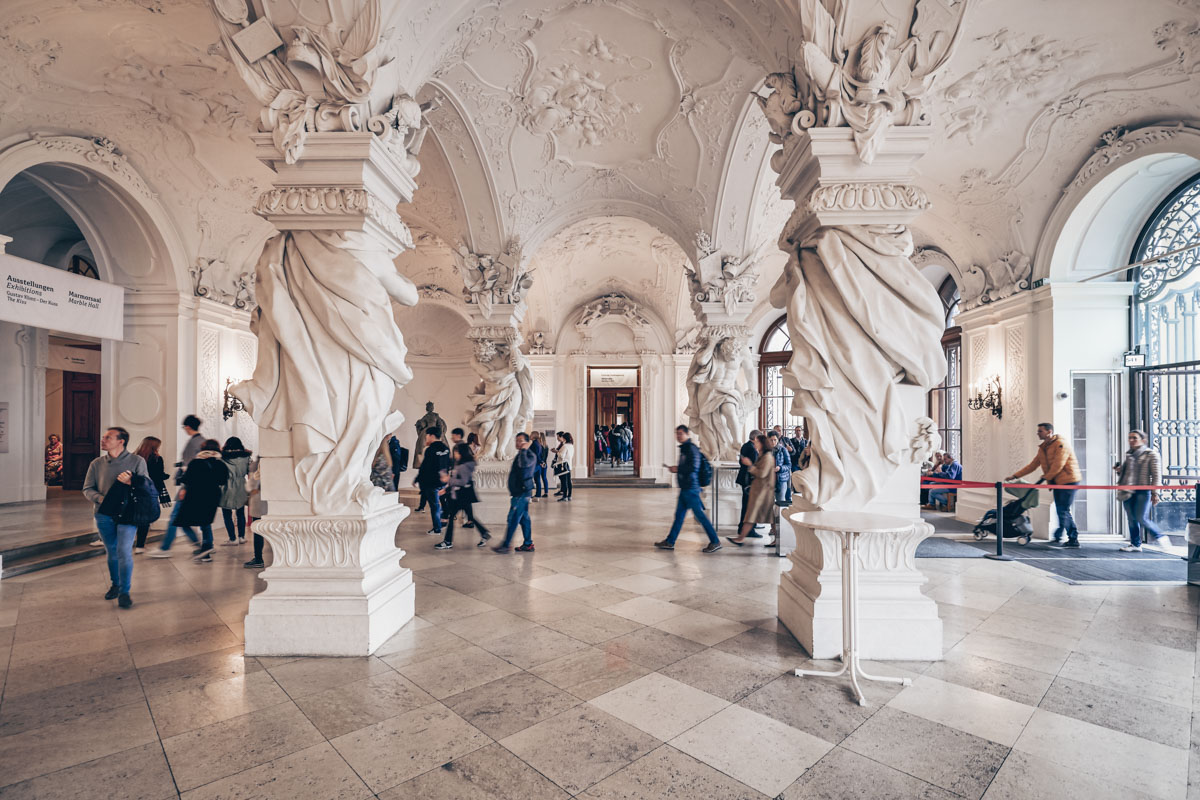
As soon as you enter the Upper Belvedere, you are greeted with a gush of some of the finest examples of Rococo interiors you will ever see.
Don’t miss the exquisite Sala Terrena hall which features four muscle-bound giant Herculean figures supporting the vaulted ceiling aswirl with ornately molded stucco.
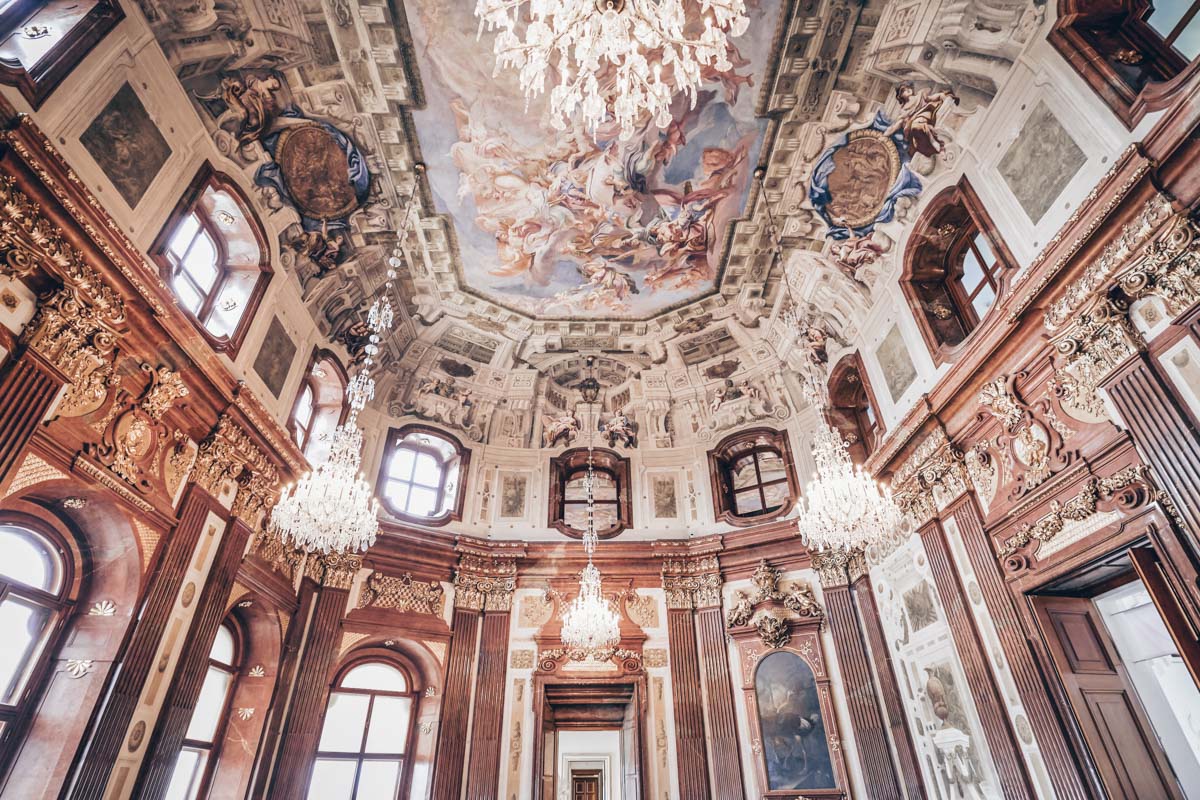
In May 1955, the Allied powers signed the Austrian State Treaty in the lofty Marble Hall of the Upper Belvedere. The treaty guaranteed the withdrawal of foreign troops in return for Austria’s neutrality. The treaty is on display in a large salon decorated in red marble.
The Upper Belvedere’s other claim to fame is being home to the Austrian Gallery, with art dating from the Middle Ages to the present day. Medieval and Baroque art is found at street level, with Neoclassicism, Romanticism, and Viennese Biedermeier on the top floor.
While these artworks are stellar in their own right, the Austrian art from the 19th and 20th centuries is undoubtedly the big draw.
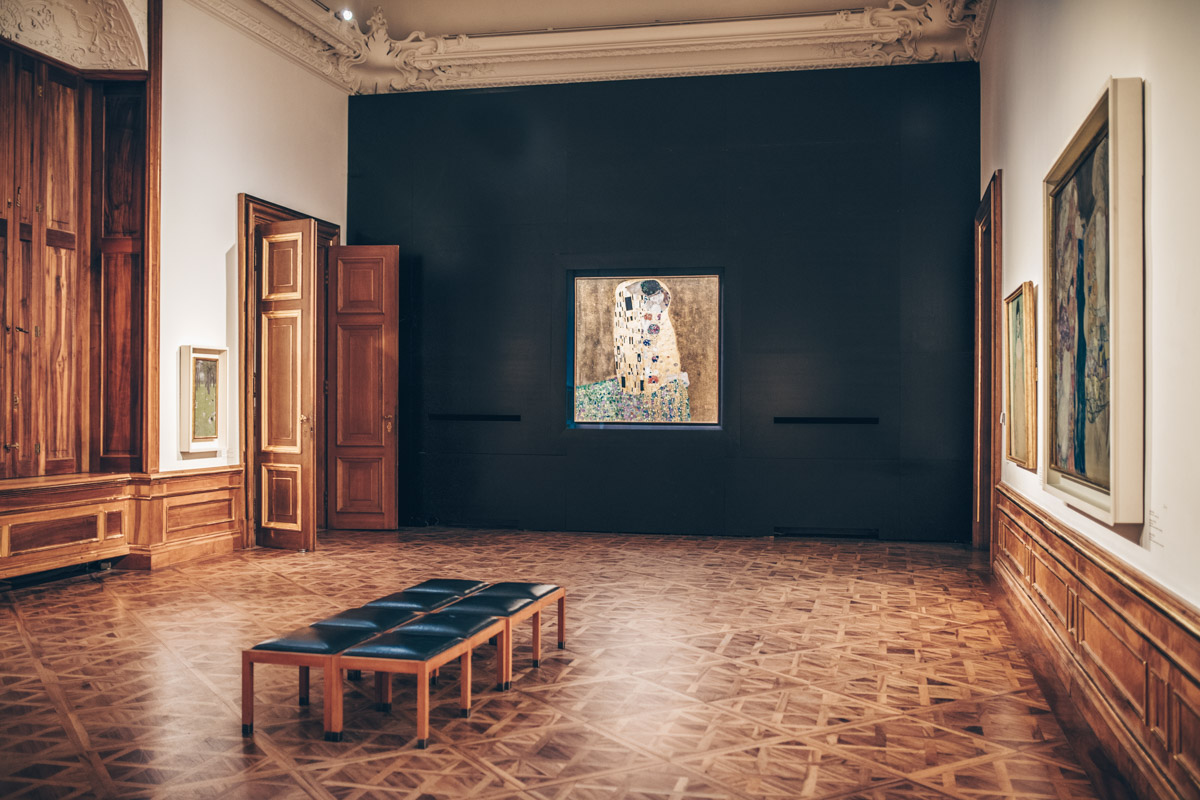
The Upper Belvedere is the best place to see the collection of works by Gustav Klimt and features his world-famous painting The Kiss. Displayed behind a protective glass shield, the masterwork shows Klimt himself embracing his long-term mistress, Emilie Flöge.
The painting perfectly captures the essence of erotic art with its elaborate patterning set against a stardust backdrop, making the couple appear to transgress the canvas. Judith and the Head of Holofernes is another one of Klimt’s seminal artworks that shouldn’t be missed.
The other unmissable artworks at the Upper Belvedere are:
- Egon Schiele’s Death and the Maiden
- Oskar Kokoschka’s Still Life with Dead Lamb
- Max Oppenheimer’s musical masterpiece The Philharmonic
- Claude Monet’s The Chef
- Caspar David Friedrich’s mist-shrouded Rocky Landscape in the Elbe Sandstone Mountains
- Richard Gerstl’s mesmerizing Laughing Self-Portrait
Make your way down the Belvedere’s formal gardens which are laid out on a wide slope, punctuated with box hedges, fountains, waterfalls, and statuary. The view from the top of the sloping gardens in the direction of the Lower Belvedere is absolutely majestic.
The garden has three levels, separated by two large cascades. Watch out for the huge statues of sphinxes in the upper half of the garden and the wonderful statues of eight muses on the lower level.
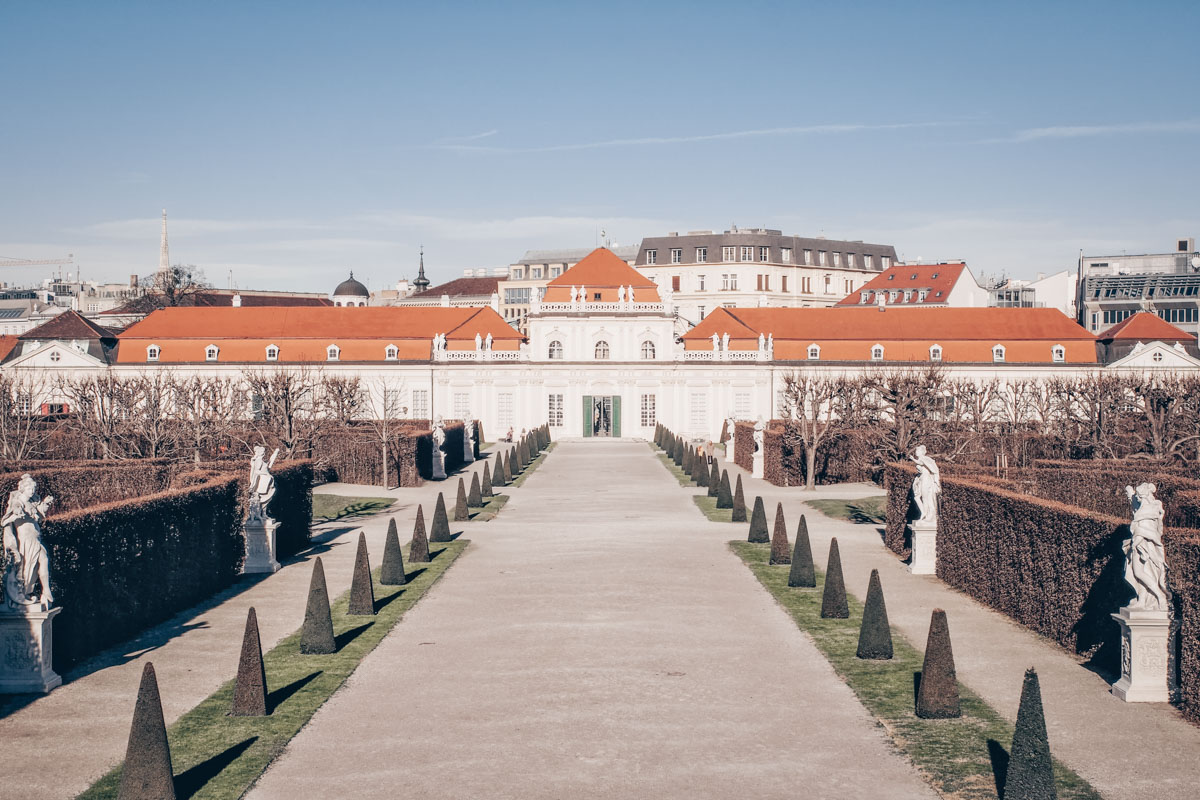
The Lower Belvedere is a relatively simple garden palace, built for Prince Eugène’s personal use, rather than for affairs of state. However, it preserves more of its plush original decor on the inside than the Upper Belvedere.
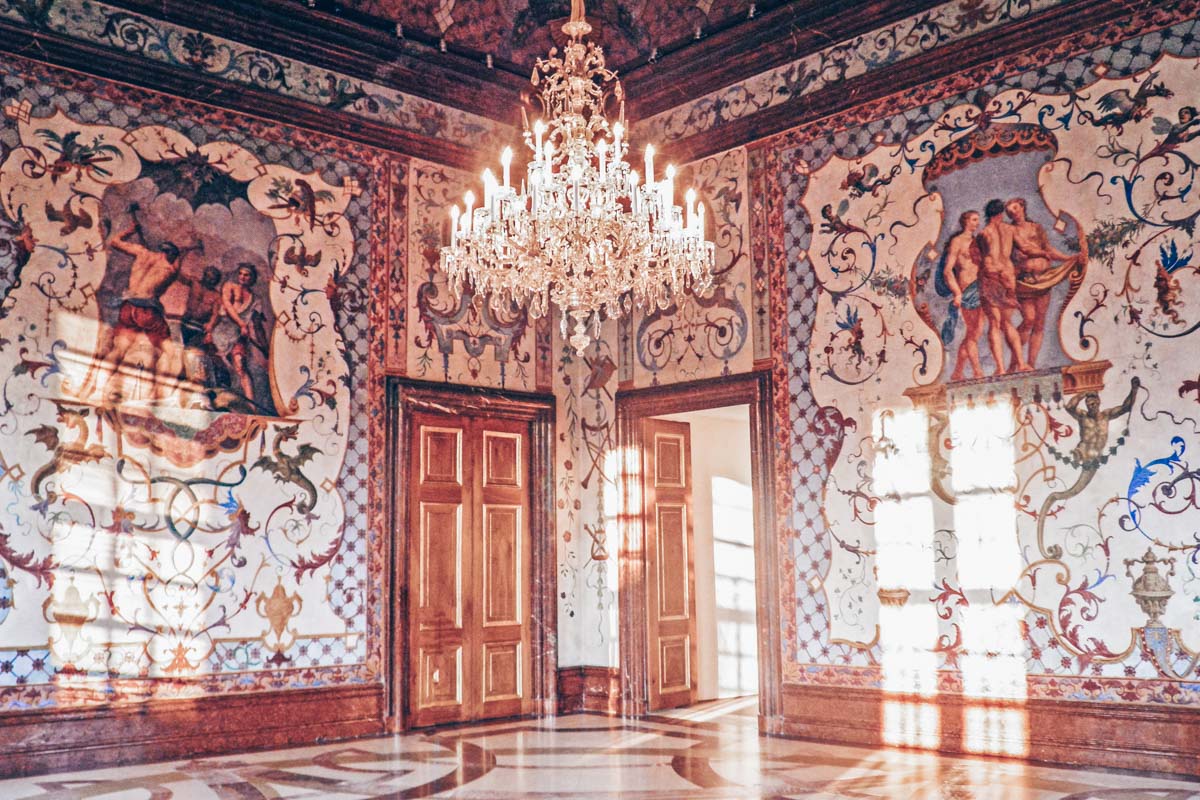
One of the best rooms to see inside is the Hall of the Grotesques whose walls are decorated with beasts and fanciful floral murals. This style of painting was derived from ancient Roman wall decorations and this is where the name “grotesque” comes from.
The hall is essentially one giant grotesque painting and the flowing, quasi-floral patterns featuring botanical, zoological, and mythological elements is absolutely mesmerizing.
The most overwhelmingly impressive room in the Lower Belvedere is the Gold Cabinet. This glittering room was later decorated with gold walls, a cabinet of mirrors, and grotesque paintwork. If there ever was a room that personifies royal decadence, this would be it.
I dare you not to take a selfie standing in front of the mirrors. The final room worth seeing is the Marble Hall, a richly stuccoed white-and-reddish-brown reception room.

Practical Information For Visiting the Belvedere Palace
The Belvedere Palace Complex is open daily from 10:00-18:00. The Belvedere Palace Gardens are open daily from 06:30 or 07:00 in the morning until 18:00 and 21:00 depending on the season.
A visit to the Upper Belvedere is only possible with a time-slot ticket meaning that you need to book a fixed entrance time.
A ticket to the Upper Belvedere costs 16.70 EUR while a ticket to the Lower Belvedere costs 14.60 EUR. The combined ticket for both palaces costs 24 EUR (you’ll save 3.30 EUR). It is better to book tickets online to avoid long waiting times.
Make use of your time wisely as there is a lot to take in here.
Prater

The final sightseeing attraction for the day is the Prater, Vienna’s equivalent of NYC’s Coney Island. The Prater is basically a large, flat tract of land, taking up nearly half the island of Leopoldstadt.
It includes large swathes of mixed woodland, racecourses, sports stadiums, a miniature railway, booths, sideshows, beer gardens, a trade-fair center, a planetarium, an amusement park, and, most famously of all, Vienna’s giant Ferris wheel. The Viennese love coming to the Prater en masse on the weekend.
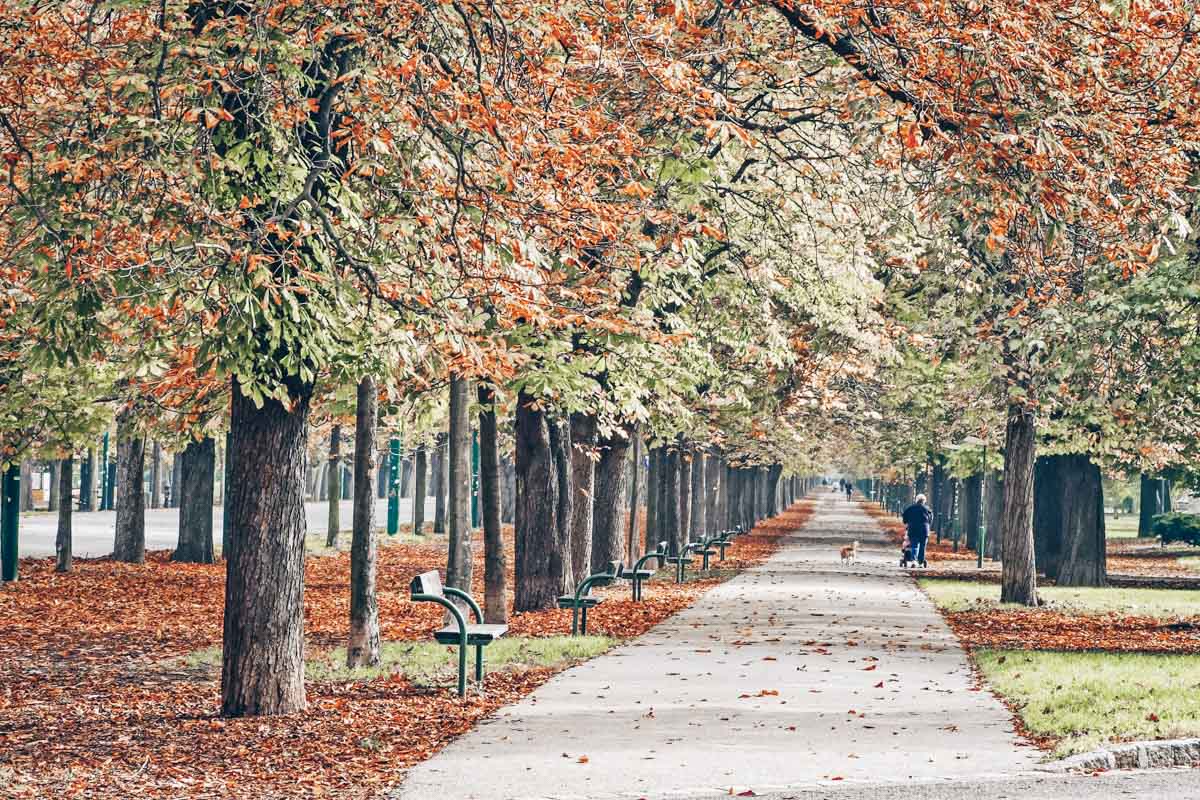
The Prater began its life as a hunting preserve and riding ground for the aristocracy. Much to the dismay of the nobility, the Prater was opened to the public in 1766 by Emperor Joseph II.
It is a popular spot for jogging and biking and the chestnut-lined Hauptallee, the main thoroughfare, is a great place for a stroll.

However, most people visit the Prater for the Volksprater Funfair. Home to an amusement park since the 19th century, the large funfair has all the typical attractions—high-adrenaline roller coasters, dodgem cars, merry-go-rounds, nostalgic rides, tunnels of love, and game arcades. The Volksprater Funfair is perfect if you have kids in tow or are young at heart.
Though the Volksprater Funfair is worthy of a visit, the main reason to visit the Prater, especially for people like me, is to see the iconic Ferris Wheel (Riesenrad). The Ferris Wheel is the most famous landmark in Vienna after St. Stephen’s Cathedral.
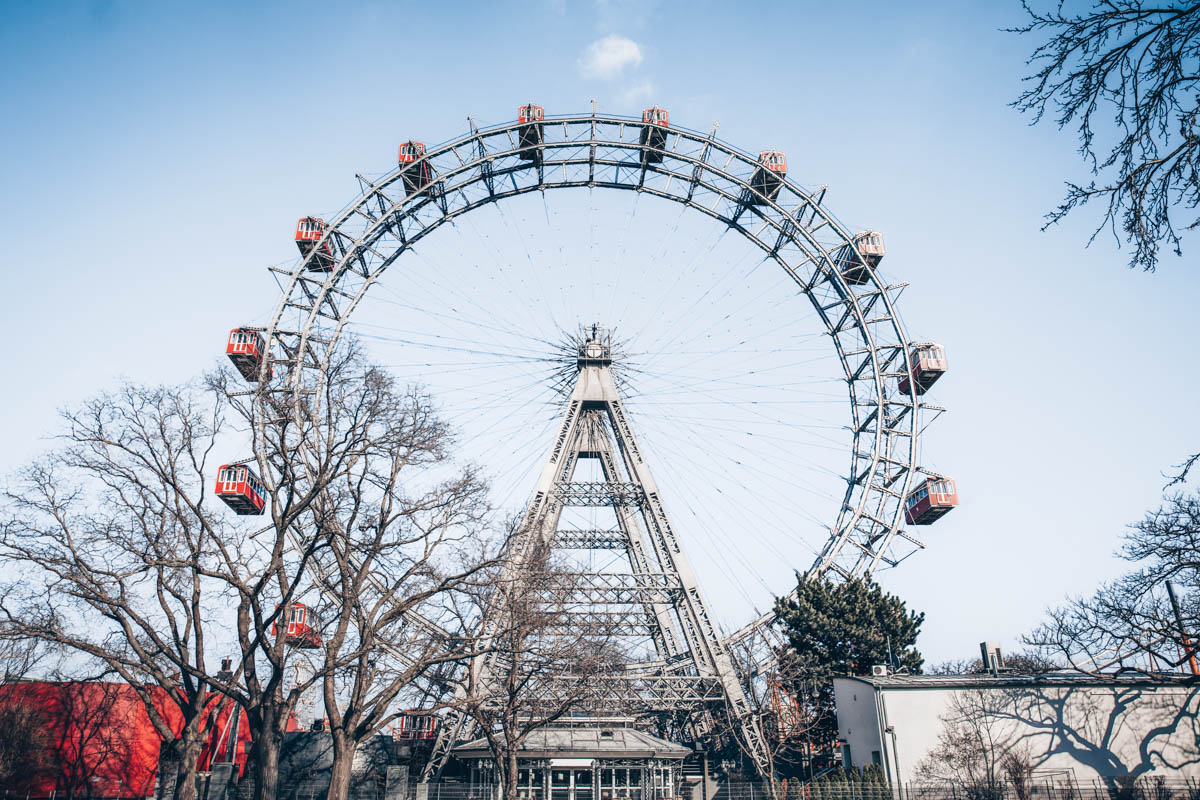
It was designed by the British military engineer Walter Basset and erected in 1897 for Emperor Franz-Josef I’s golden jubilee. Its cute little red gondolas were destroyed during World War II, and only half were replaced in deference to the wheel’s old age.
The giant Ferris Wheel became famous partly due to it being immortalized in Graham Greene’s film noir classic The Third Man. It’s the location in front of which Orson Welles does his famous “cuckoo clock” speech just after he takes a ride on the Ferris Wheel.
Since then, the huge Ferris Wheel has achieved celluloid fame in the James Bond flick The Living Daylights and Richard Linklater’s Before Sunrise.
Taking a ride on the Riesenrad is one of those things you simply cannot miss when visiting Vienna. The huge wheel circulates very slowly at a speed of about 75 cm per second, meaning it takes about 20 minutes to complete one circuit.
The Ferris Wheel is especially magical at night. It reaches a maximum height of 64 meters, allowing riders to snap some fantastic shots of Vienna.
The Prater isn’t a fenced-in park, but not all things here are open throughout the year. The season lasts from mid-March to the end of October (daily from 10:00-23:00), but the giant Ferris wheel operates daily all year round.
Admission to the park is free, but you’ll pay for games and rides. A ticket for the giant Ferris wheel costs 14 EUR. I recommend getting a convenient skip-the-line ticket to avoid unnecessary queuing.
Fun Fact: Vienna & The Third Man
Nothing has done more to create the myth of postwar Vienna than Carol Reed’s classic 1949 film noir The Third Man. Just as Salzburg is inextricably linked to The Sound of Music, Vienna will forever be linked to The Third Man. The only difference is that in Vienna’s case, the locals actually like the film whereas nobody in Austria gives a second thought about The Sound of Music. The Third Man is a personal favorite of mine and its bleak, black-and-white, expressionist cinematography, haunting theme and seedy bombed-out locations perfectly captured the fatigued, defeated atmosphere of the city at the beginning of the Cold War. Vienna was then divided into four sectors, each commanded by one of the victorious armies—American, Russian, French, and British. Reed’s film version of the Graham Greene novel features Vienna as a leading player and many of the sites where the film was shot are easily visited. It was the first British film to be shot entirely on location. When it was first released, the postwar Viennese were appalled and horrified at the depiction of their beloved city as a “rat-infested rubble heap.” Over decades, they have come to love the film, and since the early 1980s, The Third Man has been shown every Friday and Saturday at the Burgkino cinema. The film’s enduring popularity has spawned a mini tourist industry all of its own. There are regular The Third Man tours and there’s even a The Third Man museum, completely dedicated to the film!
Dinner

As long as you’re in Vienna, you definitely ought to try the classic Wiener Schnitzel. Vienna’s most famous meat dish is said to have originated in Milan.
The classic Wiener Schnitzel should be made from veal (it can also be made from chicken or pork) which is covered in breadcrumbs and fried until golden. It is normally accompanied by a potato salad in a watery, sweet dill dressing.
Skopik & Lohn is a fantastic bistro that serves one of the best schnitzels in the city. The restaurant also has an extensive wine list to accompany your meal.
Day 3 in Vienna: Cultural Vienna
Day Three of this ‘3 days in Vienna’ itinerary focuses on some vital cultural sights in the city such as the Art History Museum, beautiful examples of Jugendstil architecture, and the famous Hundertwasser House.
Breakfast at Café Jelinek

Begin your day by treating yourself to a fantastic breakfast spread at Café Jelinek. This bohemian café isn’t as well-known as some of the other famous coffeehouses in Vienna and as a result, you’re likely to come across locals in this joint.
The café’s yellow walls are adorned with signed portraits of celebrities from the Austrian theater, literature, and cabaret scene. Unlike most other coffee houses which have a polished interior, Café Jelinek has bucked the trend and reeks of shabby chic.
The food and cakes there are very good. Try the Gugelhupf—a simple sponge cake baked in a fluted ring mold and cut into slices, which was supposedly a favorite of Sigmund Freud’s.
Café Jelinek is open daily from 09:00–22:00.
Art History Museum
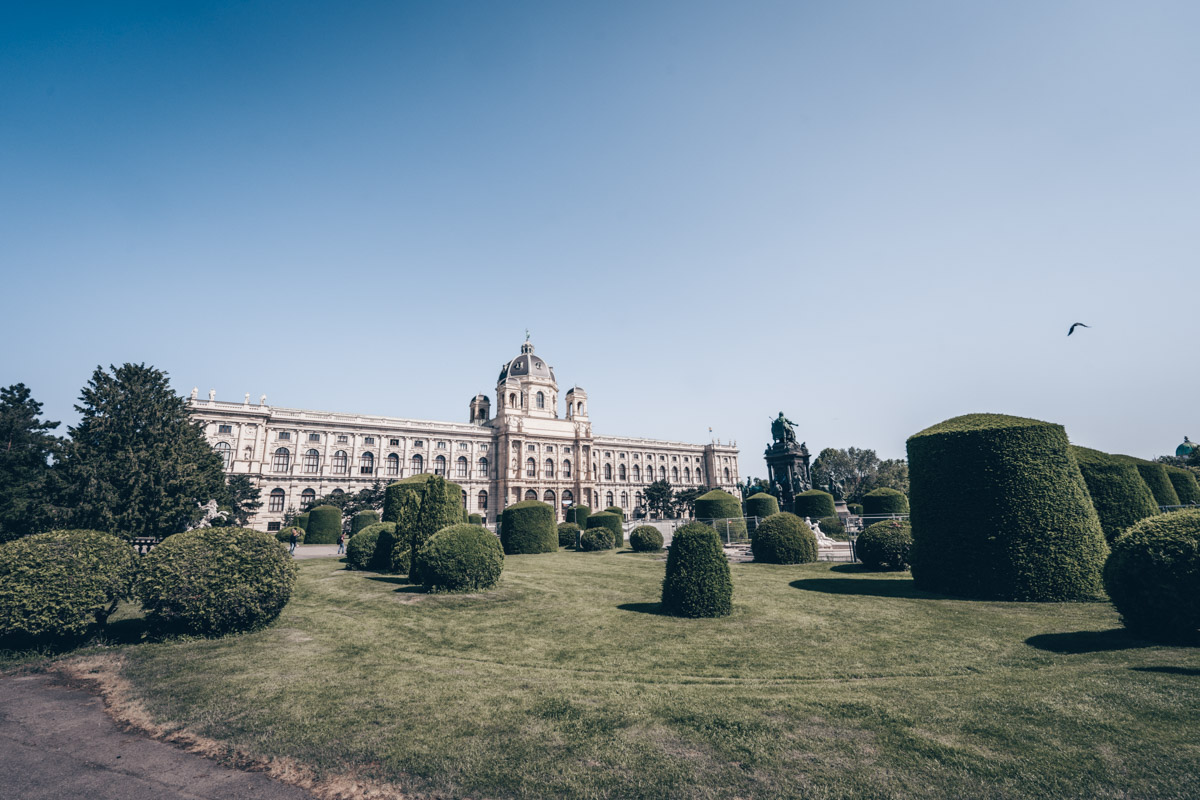
No 3 days in Vienna itinerary would be complete without visiting the hallowed Art History Museum (Kunsthistorisches Museum). Being an avid art lover, this museum is my all-time favorite attraction in Vienna and I have spent countless hours inside its hallowed walls with Mihir.
The rich collection owes its existence to the wealth of successive Habsburg rulers and contains treasures from classical Rome to Egypt and the Renaissance that play like a ride in a time-travel capsule.
The museum is housed in a huge Neoclassical edifice that’s every bit as glorious as the art it contains. The scale of the Art History Museum can be particularly daunting for first-time visitors as the vast collection is spread over three floors.
It is thus essential to go in with a plan of what to see, especially if time is limited. Otherwise, museum fatigue will get the better of you.

One of the great joys of stepping foot inside the Art History Museum is immediately being greeted by the main foyer and staircase, both of which are sumptuously decorated, from the monochrome marble floor to the richly stuccoed dome.
Antonio Canova’s imposing statue of Theseus Defeating the Centaur is a treat to observe as you ascend the main staircase as are the amazing intercolumnar murals and the lunettes on the first-floor balcony. The huge eye-catching ceiling painting celebrates “The Triumph of the Renaissance”.
A large chunk of the art collection of the Art History Museum is composed of 16th- and 17th-century masters and as such it’s a good idea to focus on these if you don’t have much time. The museum is most famous for containing the largest collection of paintings under one roof by the Dutch 16th-century master Pieter Bruegel the Elder.

Some of the most beguiling of Bruegel’s works focus on his interpretations of religious stories and allegorical peasant scenes. The most famous of these is the captivating Hunters in the Snow, in which Bruegel perfectly captures a vivid depiction of Flemish life in a wintry monochrome landscape.
Room 10 is a Brueghel shrine—on its walls hang celebrated works like Children’s Games, The Tower of Babel, The Peasant Wedding, The Return of the Herd, and The Nest-Robber.
Besides Bruegel, the museum has an excellent collection of Flemish masterworks. Peter Paul Rubens is particularly well-represented. Look out for his famous painting The Fur, an intimate portrait of Rubens’s wife in a naturally graceful pose.
Rubens’s work is also known for its Counter-Reformation themes and mythological symbolism. Works like The Worship of Venus and the Ildefonso Altarpiece are great examples of his artistic prowess. Another highlight is the many portraits done by Van Dyck and his celebrated religious painting The Vision of the Blessed Hermann Joseph.

The Dutch section also has some fantastic pieces such as Rogier van der Weyden’s Crucifixion Triptych, Hieronymous Bosch’s evocative Christ Carrying the Cross, and Jacob Van Ruisdael’s serene impression of nature The Large Forest.
Three remarkable self-portraits by Rembrandt are superb studies of exceptional realism and show why he is the master of the self-portrait. The other masterpiece you shouldn’t miss is Johannes Vermeer’s The Art of Painting, a complex work with layers of allegories.
Besides this, the museum is also loaded with Italian, Spanish & French masterpieces. You can marvel at masterworks by the likes of Tintoretto, Titian, Nicolas Poussin, Raphael, Caravaggio, and Velázquez. There are hundreds of exemplary paintings by the Old Masters and even a succinct description would go on for pages.
Before you leave the museum, take a look at the Albrecht Dürer collection. Known for his innovative art and his painstakingly detailed workmanship, the German Renaissance painter and engraver is well represented here through masterpieces like Virgin and Child with a Pear and the gruesome Martyrdom of 10,000 Christians.

Also, if you have time, take a look at the Egyptian & Near Eastern Collection. Beginning with predynastic and Old Kingdom treasures, this remarkably extensive stock of monuments includes stone sarcophagi, scarabs, canopic jars, gilded mummy masks, jewelry boxes, papyrus, pots, sphinx busts, and pharaoh statues.
The rooms here are tastefully decorated with typical Egyptian motifs and hieroglyphs. While the Art History Museum owns some superb Egyptian sculptures, the most popular item is the small blue ceramic statue of a hippopotamus, whose body is tattooed with papyrus leaves, lotus flowers, and a bird, pictorial elements from its natural swamp habitat.
In addition to all this, the Art History Museum is home to a huge numismatic collection, with coins dating back to 650 BC, statues and busts of Roman emperors, and Greek vases and statues. Unfortunately, there’s too much to take in a single visit.
The Art History Museum is open Tuesday–Sunday: 10:00–18:00 (until 21:00 on Thursday). The entrance costs 21 EUR and is well worth the price of admission. For your convenience, you can book your ticket online here.
Naschmarkt & Lunch

Visiting the Naschmarkt is a must when in Vienna and after a grueling tour of the Art History Museum, this will be a welcome respite. Although Vienna has several outdoor markets, the Naschmarkt is the city’s most famous outdoor produce market.
It’s a great place to grab a quick bite and definitely one of the premier open-air markets that I’ve come across in Europe. The Naschmarkt occupies what was originally the riverbed of a branch of the Danube River, which was diverted and paved over during the massive public works projects of the 19th century.
The market is very lively and bustling with activity where you’ll find packed rows of exotic fruits and vegetables competing for visual appeal among the hundreds of stalls.
The market commences at 06:00 when vendors selling flowers, meat, and fish open their stalls. On the weekend farmers from outside the city offer their produce and on Saturdays, a bustling flea market takes place at the tail end of the market where you can find everything from antiques to second-hand clothing.
The Naschmarkt has taken on a markedly international flavor in recent times and you’ll often smell the fragrance of spices reminiscent of Asia or the Middle East. Naschmarkt is home to many food stalls in traditional wooden huts offering Middle Eastern, South Asian, East Asian, and Balkan food.
There’s plenty of Austrian food on offer too with Austrian sausages being a popular choice. Try the käsekrainer, a fat frankfurter with tasty bits of cheese, or feast on bratwurst and the Bosna.
The Vienna Naschmarkt is open Monday–Friday from 06:00–21:00 and Saturday from 06:00–21:00. The food stalls and restaurants are open Monday–Saturday until 23:00.
To make the most out of your Naschmarkt visit, I strongly recommend taking a Naschmarkt Food Tasting Tour with a knowledgeable local guide.
Explore Viennese Art Nouveau: Jugendstil

One of the great joys of roaming the streets of Vienna is seeking out the city’s astonishing fin-de-siècle Art Nouveau architecture. This youthful (or Jugendstil) version of Art Nouveau features a sinuous and stylized form of architecture and decorative arts, known as Secession.
Jugendstil motifs are generally geometric in style and involve decorations based on plant forms such as sunflowers, as well as female figures, heads, and masks. Although you’ll see many wonderful examples of Jugendstil architecture in Vienna, the apartment houses that line the Wienzeile, overlooking the Naschmarkt, are particularly exceptional.
Two of these, the adjacent private apartment blocks of Linke Wienzeile 38 and 40, stand out in particular and are firm favorites of mine. These buildings were designed in 1899 by Secessionist pioneer Otto Wagner and are a photographer’s delight.

The building on the right (no. 38) is richly embossed with gold palm fronds and medallions and even features an elaborate top-floor loggia replete with Art Nouveau urns and a few figures.
The building on the left (no. 40) is even more flamboyant, its pollution-resistant cladding of red majolica tiles spawned the nickname, “Majolica House”. Its façade contains subtle flower patterns in pink, blue, and green.
Secession
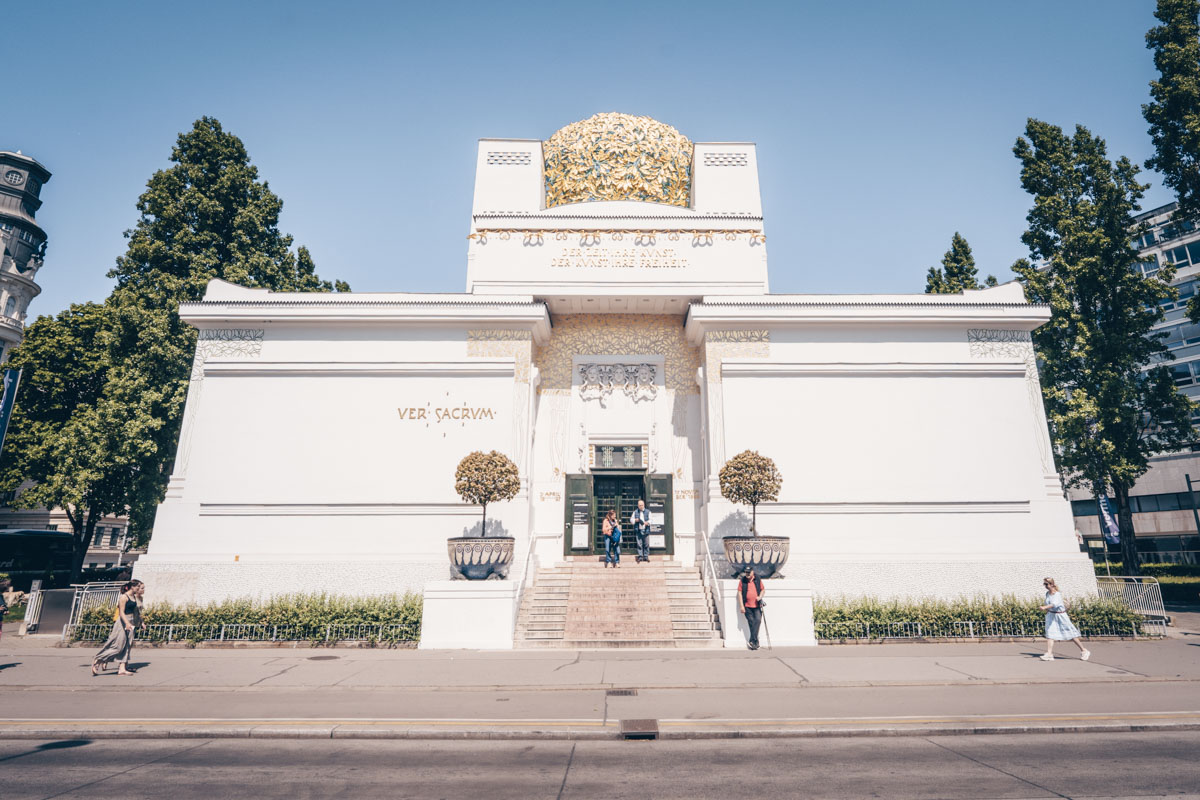
The distinctive Secession Building is arguably Vienna’s most famous example of Jugendstil architecture. The Secession Movement began in 1897, when 20 dissatisfied Viennese artists, headed by Gustav Klimt, “seceded” from the conservative and strict artists’ society associated with the Academy of Fine Arts.
It promoted the radically new kind of art known as Jugendstil, which is characterized by simple, functional lines, organic flowing motifs, and extensive use of iron, stucco, and stained glass.
The Secession Building is virtually windowless and sort of resembles a squat cube. A massive filigree dome of gilded bronze laurel leaves, its most prominent feature, rests on top of the building. Subjected to much ridicule at the time of the building’s opening in 1898, the dome is nicknamed “the Golden Cabbage”.
Nonetheless, on closer inspection, you can admire the building’s decorative details. The main entrance is beautifully adorned with a trio of gorgons, a pair of salamanders, and plentiful gilded foliage.
Above the entrance of the pavilion is the motto of the Secessionist Movement “Der Zeit ihre Kunst, Der Kunst ihre Freiheit” – “To every age its art, to art its freedom”. Just outside the building is a bronze statue of an overweight Mark Anthony, the Roman emperor is shown on a chariot being drawn by lions.

The interior of the Secession Building continues to host contemporary art installations. The main reason to step inside the building, however, is to appreciate Gustav Klimt’s Beethoven Frieze, a 34m-long visual interpretation of Beethoven’s Ninth Symphony. It was originally intended as a temporary exhibition but has now become the marquee attraction.
Drawing inspiration from Greek mythology, the frieze is utterly mesmerizing, rich in symbolism, and adorned with jewel-like details. The frieze depicts mankind’s desire for happiness and shows humanity’s struggles to conquer hostile forces such as sickness, madness, wantonness, death and finally finding eternal bliss in art.
The Secession Building is open Tuesday-Sunday from 10:00–18:00. The entrance costs 12 EUR.
Karlsplatz Pavilions
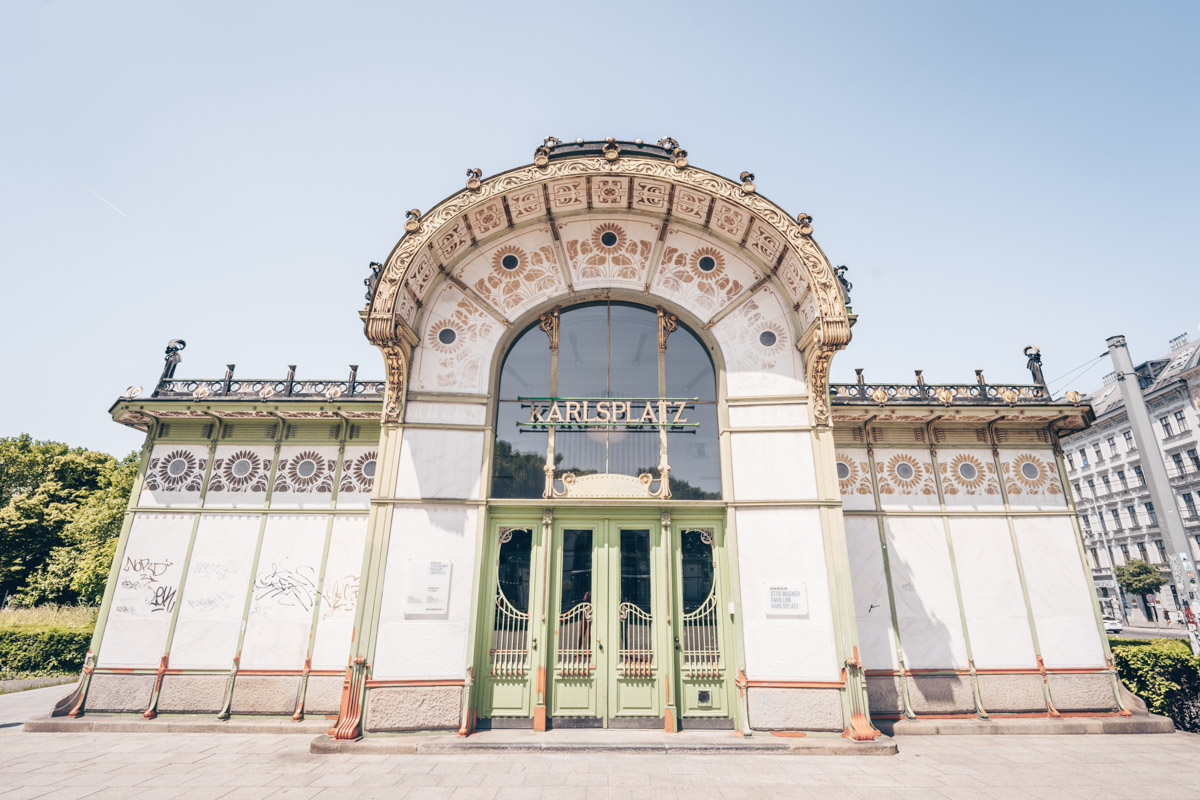
Otto Wagner, the renowned Austrian architect and leading member of the Vienna Secession movement, is responsible for several notable landmarks in the city.
Wagner was also in charge of designing and engineering many aspects of the Vienna City Train, the horsedrawn and later steam-powered predecessor of today’s underground, in the late 19th century.
Of all these structures, the identical pair of underground railway exit pavilions are certainly among his best works.
The Karlsplatz Pavilions are made of green, wrought-iron framework and marble slabs, and the roof over the arched gate is adorned with golden ornaments and sunflower motifs. These motifs are a great example of the classical Jugendstil style, combining simplicity and elegance.
Both pavilions lost their function as the Vienna U-Bahn came into use. Today, one pavilion houses a café, while the other has an exhibition on Otto Wagner.
The Karlsplatz Pavilions are open Tuesday-Sunday: 10:00–13:00, 14:00–18:00 (April–October). The entrance costs 5 EUR. Free entrance on the first Sunday of each month.
Church of St. Charles

The fantastic Church of St. Charles (Karlskirche) is one of the veritable must-see attractions in Vienna. After Vienna was hit by the plague in 1714, Emperor Charles VI vowed to build a church as soon as the city was delivered from its plight.
The Church of St. Charles was built between 1716 and 1739 and marks the pinnacle of Baroque architecture in Vienna. It is dedicated to St. Charles Borromeo, the 16th-century Italian archbishop who was famous for his ministrations of Milanese plague victims.
As you approach the church, you’ll notice the amalgam of architectural styles that have been employed in its exterior. The church is a fascinating blend of Byzantine and Baroque architecture with ancient Greek and Roman elements.
In fact, it is one of the few churches that I like better from the outside. As stunning as the church is during the day, it is even more beautiful at night when it’s bathed in light and reflected in the pond sitting in front of it.
The church’s green copper dome rises to a height of 72 meters making it a prominent feature in the Viennese skyline. The marble-white façade of the church is dominated by the Neoclassical portico.

The church’s façade is further enhanced by the presence of the two columns that are topped by giant gilded Habsburg eagles and the imperial crown. Inspired by the ancient Roman column of Trajan, these columns are decorated with scenes of the life of St. Charles Borromeo.
The left column shows the quality of steadfastness while the right one shows courage. As you make your way inside, take a look at the pediment reliefs which show the suffering of the Viennese during the 1713 plague.
The interior of the Church of St. Charles is decorated in a typically opulent Baroque manner. The High Altar is one of the highlights and features golden rays intertwined with a stucco relief showing St. Charles Borromeo being whisked away to heaven on a cloud crammed with cherubs.
Also noteworthy are the fine vault frescoes with scenes from the life of St. Charles Borromeo.
You can also take the elevator up into the elliptical cupola to get a closer look at the fresco on the dome showing the Virgin Mary imploring the Holy Trinity to bring an end to the plague. From here, you can climb the top steps to enjoy sweeping views of Vienna.
The acoustics at Karlskirche are exceptionally favorable for concerts, particularly those featuring classical music. The expansive and grandiose interior, along with the distinctive architecture of the dome, enhances and intensifies the sound, providing a crisp and resonant auditory experience.
The Church of St. Charles is open Monday–Saturday from 09:00–19:00 (until 21:00 on Thursday), Sundays, and public holidays: 09:00–20:00. The entrance costs 9.50 EUR.
Hundertwasser House
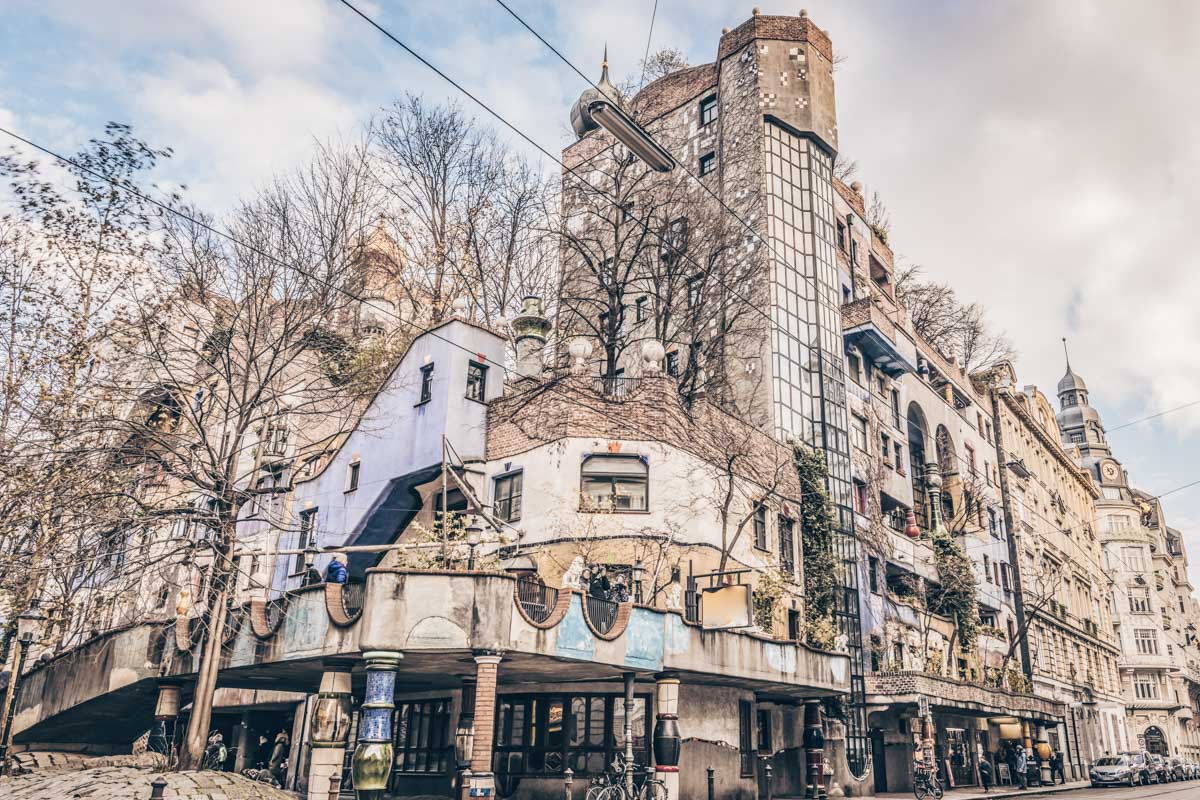
The eccentric Hundertwasser House (Hundertwasserhaus) is one of the best things to see in Vienna. With its multicolored patchwork façade, oriel windows, and spontaneous vegetation, it is one of the city’s most prominent landmarks.
This wacky fairytale-like structure vividly stands out among the rather inconspicuous architecture surrounding it. The colorful public housing unit is the concoction of the flamboyant Austrian painter and architect Friedensreich Hundertwasser.
Hundertwasser’s buildings stand out for their bright colors contrasted by black and gold, undulating floors, a notable lack of straight lines, and their highly experimental and Gaudi-like shapes that employ a variety of unusual materials, combining the artist’s vision of structures that blend with the natural environment. An unrepentant hippy, his goal was to find harmony between nature and man.

Hundertwasser designed the building in 1986 as a playful take on the usually lackluster style of social housing. Universally panned after its construction, the Hundertwasser House is now an intrinsic part of Vienna’s cultural heritage.
Since it was Hundertwasser’s goal to truly align architecture with nature in every sense, you can see several trees covering the roofs, while more trees grow inside other units, their limbs sticking out windows.
Two of the most prominent features of the Hundertwasser House are the irregular-shaped, glazed beaded columns, and the two glistening onion domes on top of the building.
Today, almost 200 people live in the building’s 52 apartments. Each differently colored section marks one apartment and the size of every apartment is visible as it is marked by an uneven line of ceramic tiles.
A remarkable feature of the building is that the individual apartments have access to a little piece of nature in the form of roof gardens and balconies that are scattered all over the building.
If you visit, just remember that the apartments are private residences and can’t be visited.
Dinner
To conclude your 3 days in Vienna, why not go to one of the city’s upcoming craft beer pubs? 1516 Brewing Company and Beaver Brewing Company are two of the trendiest brewpubs in Vienna. Both feature a great assortment of craft beers and delicious pub grub.
More Than 3 Days In Vienna?
If you have more than three days in Vienna, there are still several great attractions in the city that are worth doing which we had to leave off this itinerary. Other worthwhile attractions worth checking out in Vienna are –
Albertina Museum: This magnificent museum boasts a remarkable collection, showcasing graphic works, architectural drawings, and modern art masterpieces by artists like Monet and Picasso. Visitors can wander through its luxurious state rooms and a broad assortment of significant artistic works.
Votive Church: The Votive Church stands out as a remarkable instance of neo-Gothic architecture, adorned with detailed spires, a profound historical background, and breathtaking stained glass windows.
Sigmund Freud Museum: Situated in Freud’s old home, this museum provides an in-depth exploration of the life and contributions of the pioneer of psychoanalysis. Visitors can discover personal items, authentic furnishings, and moving displays in the actual rooms where Freud formulated his revolutionary theories.
Danube Tower: The 252-meter-tall Danube Tower is a prime destination for capturing spectacular photos and enjoying a distinct aerial perspective of Vienna, offering expansive panoramic views that extend across the city and beyond.
Vienna Museum of Technology: This cool museum offers an interactive journey through technological advancements. Explore exhibits on industry, energy, transport, and everyday tech.
Popular Tours/Activities in Vienna
Mozart Concert at the Golden Hall: Classical music lovers should experience the magic of a Mozart concert at Vienna’s Golden Hall, an iconic venue known for its breathtaking acoustics and ornate, gold-leafed interior.Viennese Underground World Guided Walking Tour: A popular activity involves discovering hidden cellars, ancient crypts, and secret passageways that reveal Vienna’s intriguing and shadowy past.
Vienna World War II Historical Walking Tour: This top-rated tour delves into the city’s dark past, exploring key sites and untold stories from the war. It’s an insightful, profound experience that brings history vividly to life.
Popular Day Trips From Vienna
If you have more than 3 days in Vienna, the city also makes a great base for day-tripping in Austria and parts of the Czech Republic, Hungary, and Slovakia.
Some of the most popular day trips from Vienna are –
Melk Abbey & Wachau Valley: Melk Abbey and the Wachau Valley offer a stunning blend of spiritual and natural beauty. Explore historic monasteries, scenic vineyards, and the serene Danube River in this picturesque Austrian region.
Mauthausen Concentration Camp Memorial: This concentration camp memorial stands as a poignant reminder of WWII atrocities. It honors the victims and educates visitors on the horrors of hate and intolerance.
Salzburg: The birthplace of Mozart enchants visitors with its baroque architecture, historic fortress, charming Old Town, and rich musical heritage, all set against the stunning backdrop of the Alps.
Hallstatt & the Alpine Peaks of Salzkammergut: Hallstatt and the Salzkammergut Alpine peaks showcase Austria’s postcard-perfect scenery. This region offers quaint village charm, stunning lakes, and majestic mountains, ideal for those seeking tranquility or adventure in nature.
Outside of Austria, three of the most popular day trips from Vienna are to the underrated Slovakian capital of Bratislava, the undeniably beautiful Czech capital of Prague, and the gorgeous Hungarian capital of Budapest.
Where to Stay in Vienna
Since most of Vienna’s attractions are located in the city center area, it is best to select a hotel close to the center. Even if you stay further out, it’s a good idea to stay anywhere on the metro line (i.e. 5-minute walk from the nearest metro station), which is part of Vienna’s excellent public transit system.
With more than 500 hotels to choose from, there is something to suit every taste and budget in Vienna, from impeccable five-star hotels to avant-garde to low-cost chains.
Hostel: Wombats Naschmarkt, a popular hostel in Vienna, within walking distance of the city center
Budget Economy: B&B Hotel Wien-Meidling, great budget option close to Wien-Meidling station
Budget Plus: Motel One Wien Hauptbahnhof, an unpretentious choice within 2 minutes of Vienna Central Station
Mid-range: Mercure Secession Vienna, a reasonably-priced 4-star hotel in the city center
Splurge: Hotel Sans Souci Wien, one of the city’s most prestigious hotels, the glamorous Sans Souci features trendy rooms and deluxe furnishings
Further Reading For Your Vienna Visit
That summarizes our definitive 3 days in Vienna itinerary. We reckon you’ll also find the following resources useful for planning your trip to Vienna!
Further Reading For Your Vienna Visit
→ Check out the 35+ Foods You Must Try in Vienna!
→ Discover the highlights of Vienna our our self-guided walking tour!
→ Uncover the 23 Best Day Trips From Vienna!
→ Discover how to spend one wonderful day in Vienna!
→ Check out our how to spend 2 perfect days in Vienna!
Now, what do you think? How would you spend 3 days in Vienna? Share your thoughts with us in the comments below!
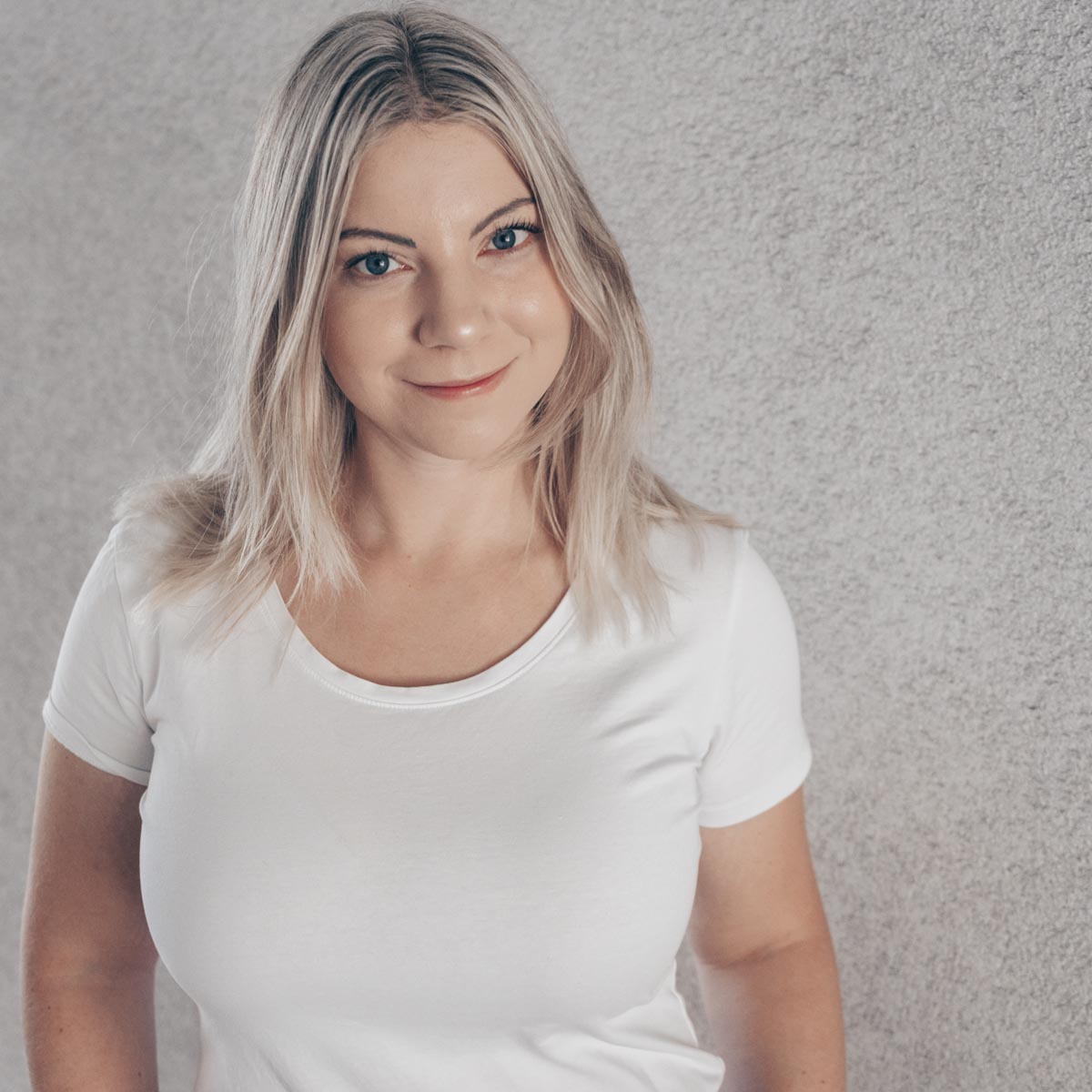
Hello there, fellow globetrotters! I’m Jacky, a passionate travel blogger with an insatiable wanderlust. With several years of experience in online marketing, I leverage my expertise to ensure that you get the best travel advice, tailored for the digital age. My travels have taken me to over 30 countries, and I love sharing those experiences with readers like you. Besides traveling, my other loves are my beloved cats, architecture, art, science fiction, coffee, and all things cute. My travel tips have been featured on lonelyplanet.com and in the EasyJet Traveller magazine.